Summary of all talks given during 2017-2019.
Click on any of the talks below or scroll down.
December 11 2019
MINCE PIE DAY IN PICTURES
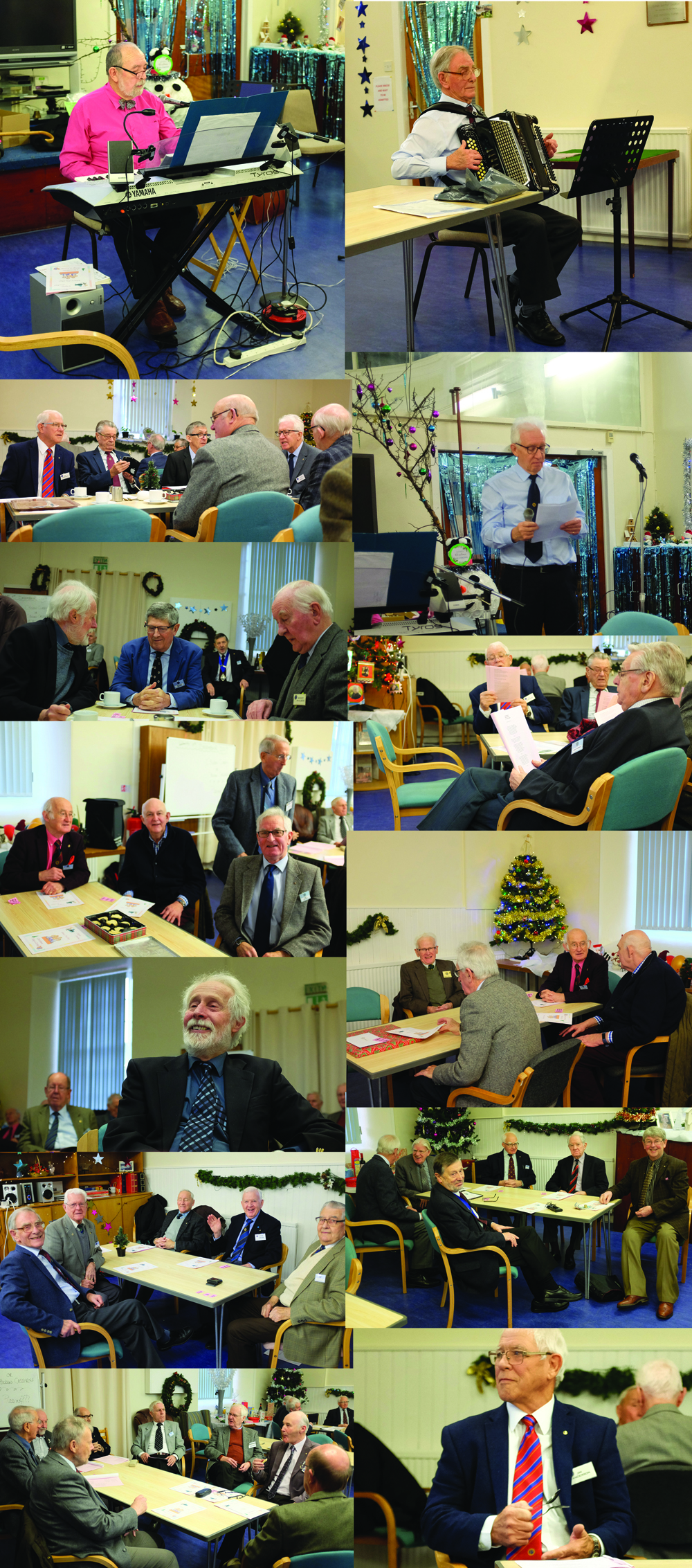
Photos by Maurice Shepherd
November 27 2019
MINCE PIE DAY HISTORY
Bert Oliver
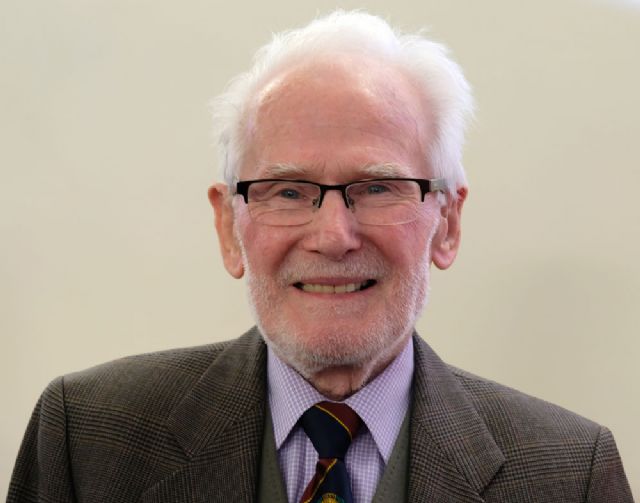
Bert Oliver
Cupar Probus Club met in Age Concern on Wednesday 27th November, when Chairman Peter Speirs welcomed 34 members and two visitors.
He then welcomed Bert Oliver, a Past Chairman, to entertain members with some history and reminiscences for older members of the Mince Pie Days held every year at the Cupar Probus Club.
Bert explained that he had trawled through minutes of the Club to find out about Mince Pie Days. The Club was formed in October 1970, but the first set of minutes were lost, so Bert was only able to find information from 1987 onwards when Mince Pie Days appeared to be in full swing.
There were natural entertainers then, such as Alistair Scott, who wrote poems for all occasions, and Sir Jimmy Shand with his accordion. In 1988 Alistair Scott provided some songs accompanied by Bob McIntosh on his violin. Several of the Mince Pie Days ended with Alistair Scott and Jack Trezise rendition of the “Bold Gendarme”.
In the mid 90s, when the attendance was about 70, Alistair wrote a poem about the water shortage in England. He also wrote a poem to celebrate the 25th anniversary of the Club which Bert read out. In 1998 Eric Neish entertained members with his trumpet, which he did several times after that. In 2002 James Morrison-Low marched up and down playing the pipes.
After that newer members took over the entertaining roles including George Wilson on accordion, John Topliss on keyboard, Bob Farmer, Bert Oliver and Colin Moore with bon mots, John McManus et al.
2015 saw the Castlehill School choir entertain members with carols, and in 2016 members enjoyed Button & Bows with their 4 accordions and a singer.
Mince Pie Day relies on newer members to keep the entertainment flowing, and Malcolm Gerdes-Hansen is one of the latest to be involved.
Bert completed his talk with a few amusing short stories and newspaper cuttings. Members added some relevant comments and Bob Farmer gave a well received vote of thanks for an entertaining and interesting talk.
The Probus Club annual lunch is being held in the Rufflets Hotel on 4th December, and the final club meeting of the year will be on 11th December in Age Concern at 9:45am. This will be this year’s Mince Pie Day and the entertainment will be led by Malcolm Gerdes-Hansen.
Report by John Topliss
November 13 2019
BY MOONLIGHT
Ron Campbell
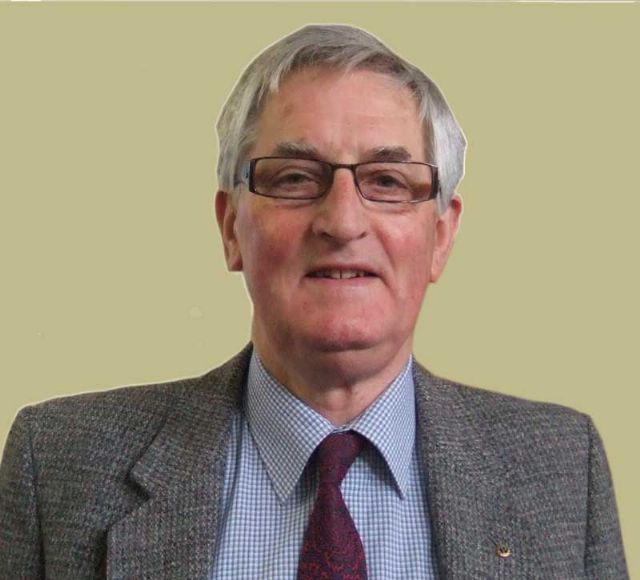
Ron Campbell
Cupar Probus Club met in Age Concern on Wednesday 13th November. Chairman Peter Speirs welcomed 38 members and 3 visitors. He also introduced the speaker for the day, Club member Ron Campbell with his talk titled “By Moonlight”.
As was expected both from his career and previous talks club member Ron Campbell’s talk dealt neither with romance nor astronomy but with military ’planes. However since these were the ’planes that worked for Special Operations Executive(SOE) from 1940 to 1945 we learnt not only fascinating details about the makes used but also about those whom they carried and their fates as they followed Churchill’s injunction to set Europe ablaze. The SOE’s principal aircraft was the Westland Lysander which handled very well at low speed and could use landing grounds only 400 yards long. It had an effective range of 700 miles, and could carry one to three passengers in the rear cockpit. Later larger aircraft e.g. the Lockheed Hudson were used and some ops were combined with the USAF. Violette Szabo was dropped from one of these: neither of the ’planes that featured in the otherwise reasonably accurate Carve Her Name With Pride was the right type. The “Lizzies” (Lysanders) guided by flashlights had to land in muddy fields in enemy occupied territory. The pilot had to navigate with only compass and maps. Sometimes three landed at once with amazing turnaround speed: once 8 passengers and 14 packages were landed and 5 passengers and 6 packages taken on board all within 9 minutes. One Frenchman picked up in 1943 was François Mitterrand, later President if France.
Ron also dealt with other individuals; he showed one photograph of 5 SOE pilots who had 24 medals among them. One had captained the bomber that featured in the famous wartime documentary Target for Tonight. The aircrews always stressed too how much they owed to the speed and labour of the ground crews. Violette Szabo has been mentioned already as probably the most famous female operative but we also heard of Noor Inayat Khan, the Muslim aristocrat who was the first female wireless operator to be sent from Britain into occupied France and who like Szabo was executed in a concentration camp. Khan’s last word, shouted at the firing squad, was “Liberté!”. Szabo had been betrayed by a double agent called Henri Déricourt. SOE had a total of 470 agents active during the war, of which 100 gave their lives for the cause of freedom. 37 women were dropped in occupied France to work as SOE agents: 13 never returned. Ron once again gave the members a well-researched and presented subject, and the Chairman proposed the vote of thanks with the customary hearty round of applause.
Report by John Topliss
October 23 2019
LIES IN WARTIME
Ian Garten
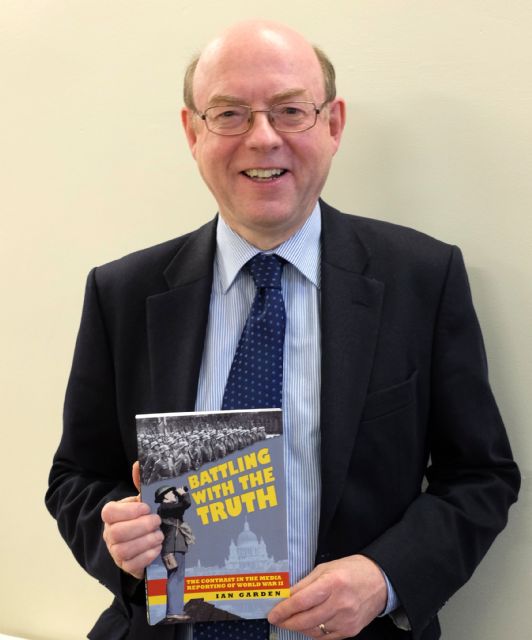
Ian Garten
Cupar Probus Club met in Age Concern Cupar on Wednesday 23rd October, when Chairman Peter Speirs welcomed a good turn out of 40 members and one guest. He made the final call for members to book their place at the Annual Lunch at Rufflets Hotel on Wednesday 4th December. Forms and payments must be received by the next meeting on 13th November.
Chairman Peter then introduced our guest speaker for today. This was the well known author and World War Two historian, Ian Garden. Ian explained that his talk today was called Telling Lies In Wartime. The inspiration for the talk came from two of his recently published books, “The Third Reich Celluloid War” and “Battling With The Truth.” These are about the quality and the partiality exhibited by media reporting by both sides in WW2.well researched and illustrated talk. Members gave their whole-hearted appreciation.
Ian explained that the 1940’s British and German public were inundated by inaccurate and sometimes deliberately false information by the Ministry of Public Enlightenment (Berlin) and the Ministry of Information (London). He made a direct comparison with the modern day Brexit Referendum saga, where both sides of the argument dealt with truths, partial truths and downright lies to try convince the public to back their side in the debate. He then explained how partial reporting on both sides was prevalent in WW2, He illustrated this by looking in detail at The Famous Dambusters Raid in May 1943. He showed how the good news of the success of the raid was immediately released allowing euphoric coverage in the British press, whereas the actual statistics of losses and damage to prisoner of war camps in the Ruhr was glossed over. By concentrating only on the positive, the reporting was at best partial. Meanwhile in Germany, the raid was ignored by their media altogether. Ian then further illustrated the contrasting ways that both sides dealt with events. He did this by showing the audience an example of the German and British newsreel coverage of the Dieppe Raid in August 1942. The British newsreel was uplifting and totally positive, concentrating on the heroism of the returning victorious British Soldiers. The contrasting Nazi coverage gave a totally opposite report on how the invasion had been decisively repulsed by the victorious German troops. The newsreels gave completely different impressions of the same event for their own home markets. Both sides had been economical with the truth to keep up morale in their own countries. Ian concluded his talk by telling us that in the Second World War a desperate public were totally trusting of both the media and the politicians. He said that today we have learned to be more cynical and sceptical. We are now well used to “false news”. If we think that something is too good to be true, that is because it probably is! Ian’s fascinating talk generated a lot of questions from the audience. Then Ron Campbell gave an enthusiastic vote of thanks which was fully endorsed by all of the members at the meeting.
Report by John Topliss
October 9 2019
AIRCRAFT QUIZ
Ron Campbell
Cupar Probus Club met in Age Concern Cupar on Wednesday 28th August, when chairman Peter Speirs welcomed 33 members and one visitor to the meeting.

Ron Campbell
Cupar Probus Club met in in Age Concern on Wednesday 9th October when Chairman Peter Speirs welcomed 32 members. Forms for the Annual Lunch on Wednesday 4th December were circulated and members were reminded to return these with their menu choice and payment by 13th November. A reminder was given to those going on the bus trip to Rosslyn Chapel to be in the Fluthers car park, ready to depart at 9am on Thursday 17th October.
Our scheduled speaker for today had called off but Club Member Ron Campbell stepped into the gap with a quiz to entertain the members.
One of Ron’s favourite subjects is aircraft, and he had devised a series of 25 questions in which the answers contained a place name which had also been used as a type of aircraft. Some of the questions were fairly easy such as England white rose town (York), and England red rose town (Lancaster). Things became more challenging however when asked about an Earl who was a king maker (Warwick), or putting your money in to a bank or society (Halifax), and a Lincolnshire tea party held here (Boston). The one that caused the most head scratching, and some amusement was, a fishy duck, not many managed to answer that one, (Bombay)! The winning team scored a very creditable 20 points from 25 questions, well done gents! The chairman proposed a vote of thanks to Ron for coming in at very short notice to give us an interesting morning in good company. The members responded with the usual hearty applause.
Report by Peter Speirs
September 25 2019
SOUTH WITH SHACKLETON
David Munro
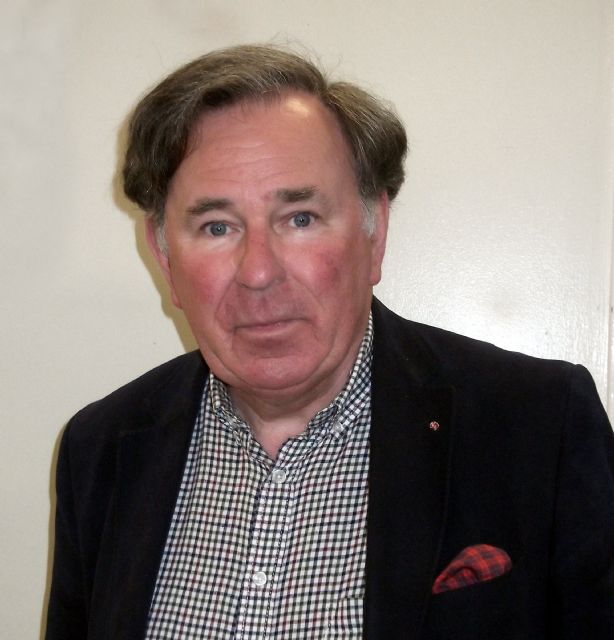
David Munro
Cupar Probus Club met in in Age Concern on Wednesday 25th September when Chairman Peter Speirs welcomed 36 members. He first welcomed a new member, Bill MacDonald who gave a brief introduction on his life and interests.
Peter then welcomed the guest speaker for the day, David Munro who was giving a talk on Ernest Shackleton who led four expeditions to the Antarctic. David was a Director of the Royal Scottish Geographical Society, and also the secretary for a time, this being the previous job of Shackleton. He is now a Freelance Geographical Consultant.
Ernest Henry Shackleton was born in County Kildare in Ireland on 15th February 1874. His father was a doctor and wanted his son to follow in his footsteps, but instead he joined the merchant navy and qualified as a master mariner in 1898. In 1901 Shackleton was selected to go on the Antarctic expedition led by Captain Scott on the Discovery. The ship Discovery was specially built for the venture, and was constructed as a wooden sailing ship, with auxiliary engines, measured 172 feet long and weighed 485 tons. Built in Dundee, the Discovery left on 31st July 1901 to sail south to Antarctica. Discovery is now in Dundee as a permanent public display. This expedition reached the latitude of 82 degrees south, closer to the south pole than any previous attempt. Unfortunately Shackleton became ill on this trip and returned home early.
In 1908 he returned to the Antarctic on his own expedition on the Nimrod. During this expedition his team climbed Mount Erebus, the most active volcano on the continent, and made important scientific discoveries. They ventured even further south to 88 degrees, just 112 miles from the pole. On his return Shackleton was knighted by King Edward the seventh.
In 1911, Norwegian explorer Roald Amundsen reached the south pole, followed by Captain Scott who perished on the return journey. Shackleton then turned his attention to crossing the Antarctic from sea to sea, via the south pole.
His third trip to the Antarctic was on the ship Endurance and started in 1914, and this was thought to be useful as a publicity diversion in a world which had just became involved in WW1. Early in 1915 the Endurance became trapped in ice and the crew abandoned the ship to camp on the ice. In April 1916 they used three lifeboats to reach Elephant Island. Shackleton and five others again set to sea and they spent 16 days crossing the ocean to reach South Georgia, where they trekked across the island to a whaling station. From here they arranged help and in August 1916 all the members of the expedition were safely rescued and returned home.
Shackleton attempted a fourth expedition to circumnavigate the Antarctic, but on 5th January he died of a heart attack while his ship was moored in South Georgia. At his wife’s request he was buried on the Island, and a memorial was erected in his memory.
Speaker DaPeter then welcomed the guest speaker for the day, David Munro who was giving a talk on Ernest Shackleton who led four expeditions to the Antarctic. David was a Director of the Royal Scottish Geographical Society, and also the secretary for a time, this being the previous job of Shackleton. He is now a Freelance Geographical Consultant.
Ernest Henry Shackleton was born in County Kildare in Ireland on 15th February 1874. His father was a doctor and wanted his son to follow in his footsteps, but instead he joined the merchant navy and qualified as a master mariner in 1898. In 1901 Shackleton was selected to go on the Antarctic expedition led by Captain Scott on the Discovery. The ship Discovery was specially built for the venture, and was constructed as a wooden sailing ship, with auxiliary engines, measured 172 feet long and weighed 485 tons. Built in Dundee, the Discovery left on 31st July 1901 to sail south to Antarctica. Discovery is now in Dundee as a permanent public display. This expedition reached the latitude of 82 degrees south, closer to the south pole than any previous attempt. Unfortunately Shackleton became ill on this trip and returned home early.
In 1908 he returned to the Antarctic on his own expedition on the Nimrod. During this expedition his team climbed Mount Erebus, the most active volcano on the continent, and made important scientific discoveries. They ventured even further south to 88 degrees, just 112 miles from the pole. On his return Shackleton was knighted by King Edward the seventh.
In 1911, Norwegian explorer Roald Amundsen reached the south pole, followed by Captain Scott who perished on the return journey. Shackleton then turned his attention to crossing the Antarctic from sea to sea, via the south pole.
His third trip to the Antarctic was on the ship Endurance and started in 1914, and this was thought to be useful as a publicity diversion in a world which had just became involved in WW1. Early in 1915 the Endurance became trapped in ice and the crew abandoned the ship to camp on the ice. In April 1916 they used three lifeboats to reach Elephant Island. Shackleton and five others again set to sea and they spent 16 days crossing the ocean to reach South Georgia, where they trekked across the island to a whaling station. From here they arranged help and in August 1916 all the members of the expedition were safely rescued and returned home.
Shackleton attempted a fourth expedition to circumnavigate the Antarctic, but on 5th January he died of a heart attack while his ship was moored in South Georgia. At his wife’s request he was buried on the Island, and a memorial was erected in his memory.
Speaker David Munro had visited several of the expedition sites and showed many pictures to add to his fascinating talk. The vote of thanks was given by Malcolm Gerdes-Hansen and the members responded with the usual hearty applause.
Report by Peter Speirs
September 11 2019
HEALTHY EATING
Lyndsey Clark
Cupar Probus Club met in Age Concern Cupar on Wednesday 28th August, when chairman Peter Speirs welcomed 33 members and one visitor to the meeting.
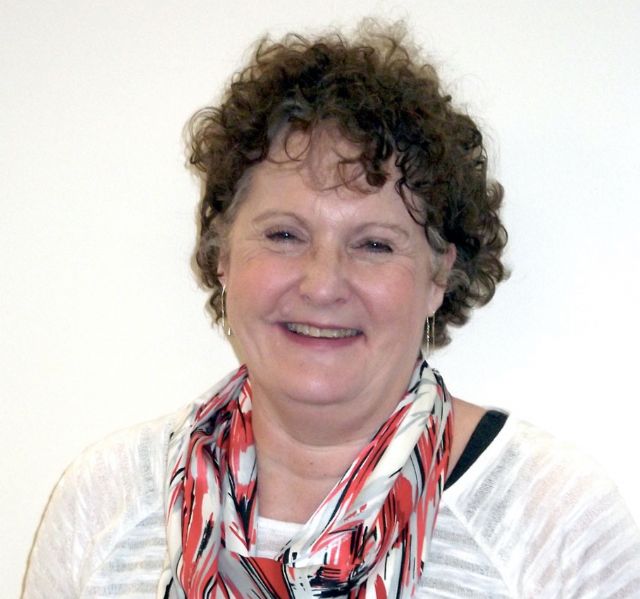
Lyndsey Clark
Chairman Peter Speirs introduced our guest speaker for the day, Lyndsey Clark, who gave advice on healthy eating. Lyndsey gave a sparkling talk providing as someone said, much food for thought to Probus members, most of whom were old enough to remember wartime and post war rationing, and the days when unhealthy eating was offset by physical exercise.
She concentrated on eight main areas: fresh fruit and veg; two portions of fish, one oily one not; importance of breakfast; reducing red meat; the value of eating eggs; reducing sugar, fats, and salt; the importance of brown bread and dairy foods; and taking in enough fluids during the day. However she stressed that there were no unhealthy foods as such: it was their unbalanced choice that was damaging. For example meat and fats were necessary but only in moderation. She extracted these principles by cleverly involving her audience in question and answer and discussion.
While some of her areas like the importance of eating breakfast was more applicable to younger listeners there were two points she wanted to stress for older eaters: the vital importance of intaking Vitamin D and of drinking a litre of fluid a day. Moderation in all things was her theme for our membership: a formulation not just pre-war but pre-war by some 2,700 years.
The vote of thanks was given by David Cleland and the hearty applause from the members showed how much they enjoyed the presentation by Lyndsey.
Report by David Cleland
August 28 2019
SATURN V
Maurice Shepherd
Cupar Probus Club met in Age Concern Cupar on Wednesday 28th August, when chairman Peter Speirs welcomed 33 members and one visitor to the meeting.
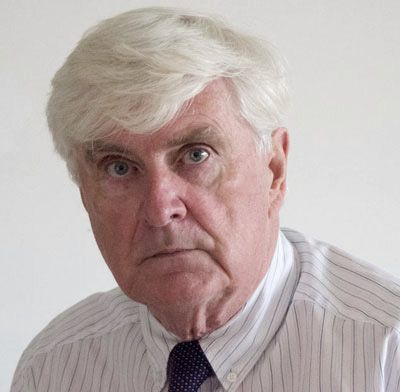
Maurice Shepherd
The Chairman, Peter Speirs, invited Vice Chairman, Maurice Shepherd, to talk about the Saturn V rocket and welcomed him by crooning a couple of lines of “Fly Me To The Moon”, much to everyone’s amusement.
Against the background of a Saturn V rocket taking off in slow motion, Maurice explained that he wanted to give a technology-based talk which was factual and interesting. The Saturn V was probably the biggest rocket in the world, at 363 feet high equivalent to the height of a 36 story building; at take-off it burned 50 tonnes of fuel per second. He showed a series of photos which demonstrated the parts and enormous size of the rocket which highlighted the minute capsule holding the 3 astronauts.
Maurice then went through some of the history of rocketry starting with the Nazi V2 Vengeance Weapon in 1944 which created such devastation in the London area, where it killed 33,000 people. This rocket was the first to cross the Karman line, which at about 60 miles high divides the atmosphere from space.
After the war, both the Russians and Americans seized German rocket technology but rocket specialist, Werner von Braun, went on to develop rockets in the US. The nuclear Intercontinental Ballistic Missile (ICBM) was one of the outcomes of this work.
In 1957 the Russians put the Sputnik satellite into orbit, shortly followed by a dog, Laika. Russian Yuri Gagarin in Vostok was the first man in orbit in 1961, with the first American, John Glenn, in orbit the following year. In 1962 these and other activities prompted US President, John F Kennedy, to make his famous speech to get men to the moon and back safely within the decade. This helped to kick-start the Apollo spacecraft programme and the development of the Saturn V rocket.
The Saturn V is a 3 stage rocket with 5 engines in each of the 1st and 2nd stage and one engine in the 3rd stage. The Apollo Spacecraft which sits on top consists of a Command module, Service module and Lunar module. Maurice explained the complicated procedure to manoeuvre the relevant modules into position during different parts of the mission.
There were 17 Apollo missions in all between 1967 to 1971, of which 6 actually went to the moon. Apollo 1 had a disastrous fire which killed its astronauts, Apollo 8 was the first mission to use the Saturn V, Apollo 11 was the first mission to get to the moon and memorably, Apollo 13 nearly didn’t get back. After this Saturn V was used to take material to the International Space Station.
There were several questions and observations from members, after which John Topliss thanked Maurice for his fascinating, well researched and illustrated talk. Members gave their whole-hearted appreciation.
Report by John Topliss
14 August 2019
THE BARD OF THE YUKON
Martin Hepworth
Today, Martin’s subject was “The Bard of the Yukon!” This talk was all about the life and adventures experienced by the poet and verse writer, Robert Service.
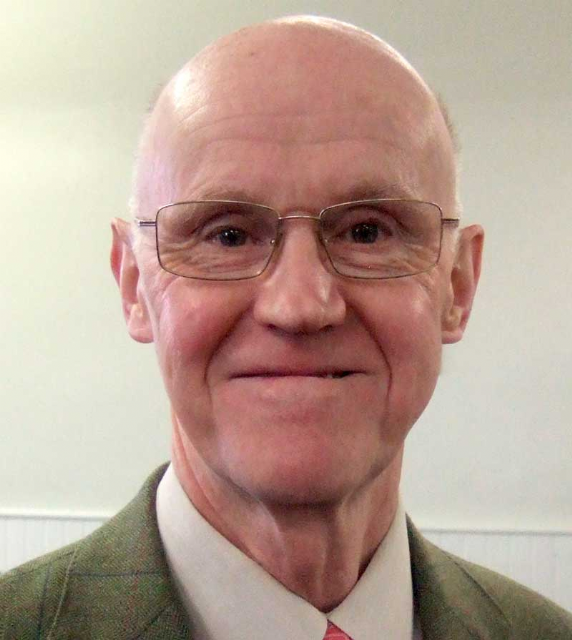
Martin Hepworth
Martin took us through the life and times of Robert Service. He was born in Preston, Lancashire of Scottish descent in 1874. He was a bank clerk by trade, but spent long periods in the Wild West frontiers of Canada. Our speaker conjured up graphic images of the dangers and perils of Yukon life in those far off days. A place where survival was a game of chance! But, against all of the odds, Robert Service lived well and indeed prospered. Martin cleverly peppered his talk with some of the poetry and verse written by Service. This helped to illustrate his lifetime experiences. He was inspired by tales of the Yukon Gold Rush to write poetry revealing the comedy and angst experienced by the miners scrabbling for their share of the gold. These poems enjoyed immediate success and popularity during the lifetime of Robert Service and are still amusing to audiences today. Martin’s reading of such classics as the “The Dangerous Dan McGrew” earned an appreciative round of applause from a receptive audience. Robert Service became a wealthy man because of his poetry and could afford to travel widely and live a leisurely life. He based himself in Paris and the French Riviera. His works were dismissed as doggerel by critics at the time, but today he is classed almost in the same league as Kipling. This talk generated a wide range of questions and provided some very interesting insights from members of the audience. These acted as an excellent supplement to a most interesting talk. Colin Moore gave a very well deserved vote of thanks. He thanked Martin for his regular visits to the club and commented on the amusing and by turns, serious content of today’s talk. Colin’s vote of thanks was heartily and enthusiastically endorsed by all present. Cupar Probus Club will meet again in Age Concern at 9:45 on Wednesday 28th August, when club Vice Chairman Maurice Shepherd will give us a talk on the Saturn V rocket which was used in the moon landing expeditions. .
Report by Colin Moore.
24 July 2019
THE BRITISH SLAVE TRADE
Malcolm Gerdes-Hansen
Malcolm Gerdes-Hansen, one of our own members, gave a fascinating lecture on slavery obviously based on a large amount of research and reading. Although the main theme was slavery in British history, he well began with the institution’s beginnings. Not practicable with hunter gatherers or in early agriculture it began in cities where the more advanced services and trades required manpower with war usually its main source.
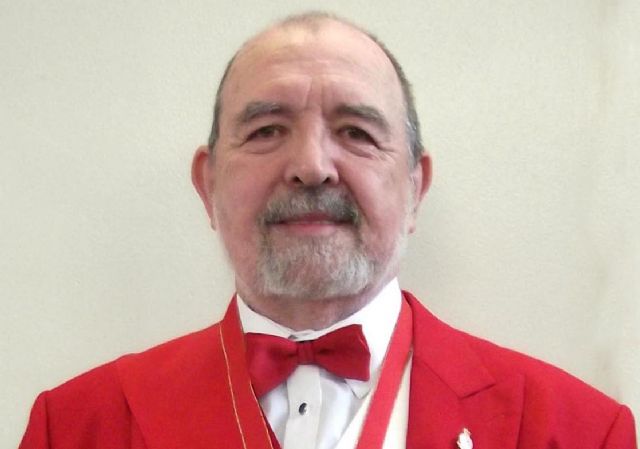
By the eighteenth century B.C. Babylon was spelling out the legal status of slaves in the codes of Hammurabi. Greece and Rome were the two leading slave societies of the ancient world. First century B.C. saw the famous rebellion of Spartacus: how seriously this was taken was shown by the fact that the 6,000 surviving rebels were crucified along the Appian Way, an immense logistical undertaking. Malcolm pointed out that ancient war galleys were understandably manned by trained free marines. Modern ideas of slavery are based on the taking of slaves from Africa to the Americas by the Portuguese and later the British, but in fact from the seventh century A.D up to the 1900s the Arabs had a lucrative trade in humans stretching as far east as China. As with all slave transportation mortality rates were appalling: perhaps 80% died en route. The Portuguese began taking slaves from North Africa into Europe in 1444, 50 years before Columbus. Malcolm explained the triangle of trade from Britain: to Africa guns, alcohol etc. to pay for the slaves; to America slaves; to Britain goods such as sugar and cotton. The local rulers who sold slaves could become incredibly wealthy: the King of Dahomey in West Africa raked in £250,000 per annum. Though London started as the main port it became much easier to ship from the west coast from Bristol, Liverpool, and Glasgow: the wealth these cities reaped from this trade is only beginning to be acknowledged today and the preservation of honoured names in some buildings and institutions questioned given the source of the wealth that funded the building. Malcolm ended with two examples from slaving history: one little known and the second much more familiar though not in this context. The first was the massacre of 130 slaves thrown overboard from the slave ship Zong both to preserve water rations and to claim the insurance. The second was an account of the life of John Newton whose experiences as captain of a slave ship led to his conversion and career as a clergyman and writer of hymns which include “Glorious Things of Thee Are Spoken” and “Amazing Grace”. Sadly the lecture finished with horrifying examples of slavery today, such as prisoners taken by Islamic State or Poles smuggled into the UK to work for a pittance and live in primitive conditions Colin Moore gave the vote of thanks, and the members showed their appreciation of Malcolm’s talk in the usual way.
10 July 2019
PLAYING CARDS
Jim Boyd
The Vice Chairman, Maurice Shepherd, welcomed Jim Boyd to talk about Playing Cards. Jim, a member of Glenrothes Probus Club and President of Kirkcaldy Magic Circle, explained that he had a particular interest in playing cards. While playing cards were only bits of cardboard they had history, mystery and stories.
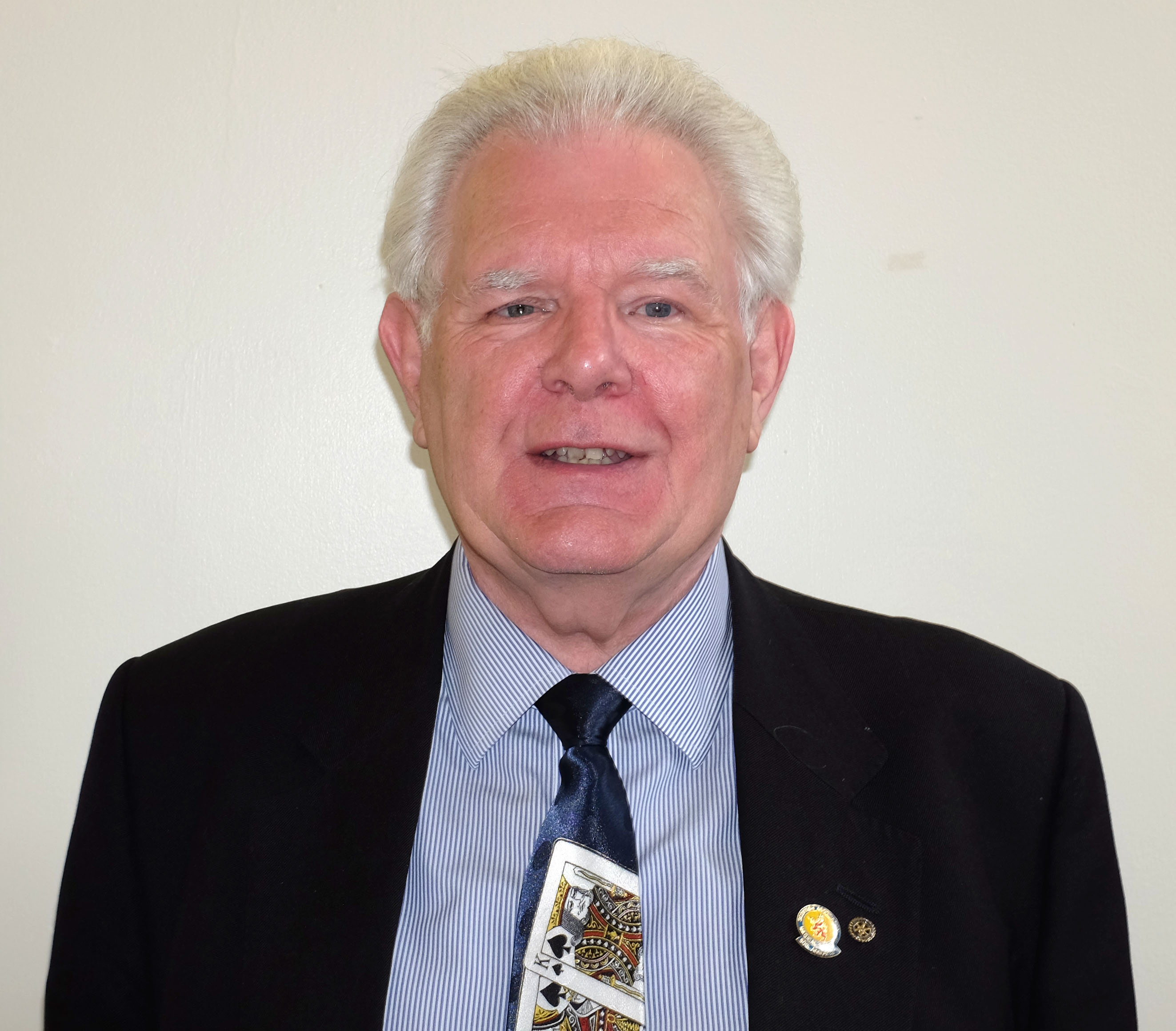
Jim Boyd
Jim started his talk with a short card trick just to get this audience in the mood, then went on to explain that playing cards were most likely to have started in China, where paper was invented, about the 9th century. The cards gradually moved to the Middle East, then with the Arabs to Europe via Spain. The Topkapi museum in Istanbul has some of the oldest cards dating back to the 15th century. Playing cards were so influential then that an Act of Parliament in 1486 forbade the import of playing cards. Jim then went on to talk about different types of cards, including the 78 cards in a Tarot pack. While originally just used for fortune telling they could be used for black magic. Aleister Crowley, who died 1947, was known as The Beast, and was a well known master practitioner on the dark arts including using Tarot cards. Boleskine House, his house near Loch Ness, was reputedly cursed and burnt down. Playing cards have have been shown in many older paintings such as the Meliadus painting c 1352 in the British Museum showing men playing cards, and some cards shown in the detail of the 16th century Garden of Earthly Delights by Hieronymous Bosch. Jim showed us that playing card suits have changed over the years and they are still different in some other countries today. The Hearts, Spades, Diamonds and Clubs were adopted from the French cards, and the court cards apparently relate to real royalty with stories about the detail in the pictures. Playing cards started having patterns on the back about 1860 to prevent cards being too easily marked to allow cheating, but as Jim showed, the fussy pattern on the back of a marked pack can be subtly marked and difficult to spot. Jim referred to the Soldiers Almanac of 1762 which related the 4 suits to the seasons of the year, the 12 picture cards to the months, etc., which was made into a song by Max Bygraves. He followed that with a lot of interesting detail of the 3 card trick scam carried out in London by teams of up to 8 crooks at a time to defraud the punters. Jim then finished his talk with a card trick and a demonstration of a variety of shuffles. After Jim had responded fully to several questions, the Vice Chairman thanked him for his fascinating and well illustrated talk. Members agreed by showing their whole-hearted appreciation.
26 June 2019
PERSONAL SAFETY
PC Laird & MacLeod
Cupar Probus Club met in Age Concern on Wednesday 26th June when chairman Peter Speirs welcomed 37 members and 1 visitor. After the short business session, Peter welcomed our guest speakers for today, PC Keith MacLeod and PC Frazer Laird from Police Scotland to give a talk on personal safety.
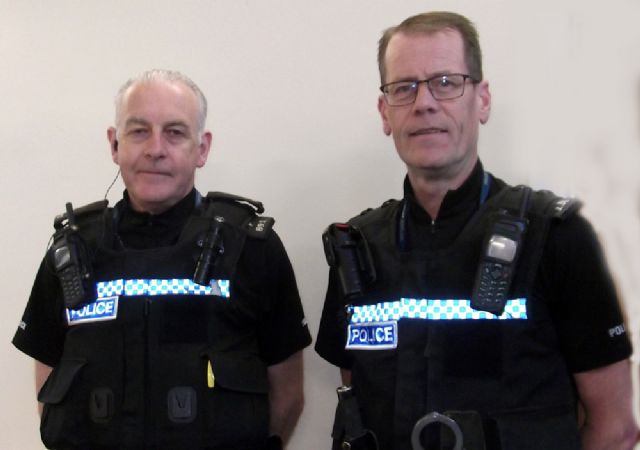
PC Laird and PC MacLeod
PCs Frazer Laird and Keith MacLeod from Dunfermline talked about three areas: 1) home security 2) scams 3) ATMs.
1) At home, doors should be kept locked even with residents in the house and the key not kept in the lock but nearby. Insurance would not cover theft if house unlocked or window left open. Most thefts were “sneak-ins” and the average time for them in winter was between 4 and 6 p.m.: therefore timer lights should be installed to come on randomly and a radio (but not TV) be left on. Jewellery should be photographed: much easier than having to describe it once gone. Monitored alarms are the best but there was a strong recommendation of Sonis Europe, a device made in Dunfermline and hopefully available by the end of this year.
2) Scams came by post, the internet, and by ’phone. Strong passwords and firewalls were essential. Links in dubious e-mails (e.g. beginning “Dear Customer” rather than by name) must never be opened. Cold telephone callers now have genuine local numbers. If they become obtrusive monitoring can be put in place e.g. Citizens Advice Bureaux’ TrueCall.
3) A mock-up of an ATM was produced and the various ways thieves could interfere with it exemplified e.g. by installing cameras to photo the card, sometimes on upper part which is why PINs should be covered when being entered. If notes do not emerge try to leave someone outside while going in to tell bank so that the thieves cannot remove the obstruction, take the money, and replace the obstruction. It is much safer using ATMs inside the bank if possible. If your card does not emerge ‘phone the emergency number on the back, a number which you must have noted already as the card will not be available. If there are two ATMs side by side one with a notice attached saying “Use other ATM” don’t! If filling stations give a choice between paying at kiosk or at pump pay at kiosk. Contactless cards can be cloned by a nearby mobile ’phone app and so need a protective plastic cover available from the police at 50p. Cashback is actually the safest way of drawing money. In 2017 ATM fraud cost the banks £400 million and they can only retrieve this by upping charges. As for cowboy tradesmen on the doorstep it is much better to use the Fife Trusted Trader scheme if necessary. Most of PC Laird’s examples came from a big city like Dunfermline but those of us lucky enough to live in quieter area must still be on our guard against crime.
Many questions were answered during the presentation, and a further session at the end of the talk showed how much interest the members had in the subject matter. The vote of thanks was given by Treasurer Brian Knight and the members responded with hearty applause.
Report by David Cleland12 June 2019
CLIMBING KILIMANJARO
Jack Dempsey
Chairman Peter Speirs welcomed 32 members to today's meeting and also a small delegation of 7 members from the Cowdenbeath Probus Club.
Cowdenbeath Club visited last year, and were led on this occasion by their Chairman Alan Dunlop. It was their club Secretary, Walter Taylor who gave a few words of thanks for the warm welcome received.
Peter then introduced our speaker for today – Jack Dempsey, who would give us his experience on climbing Mount Kilimanjaro. Jack retired quite recently from working for some 30 years for the Saudi Arabia Oil Co. He has BSc and PhD degrees from Heriot Watt University in Edinburgh in Electrical Engineering, and is still a volunteer worker for the Institution of Engineering Technology.
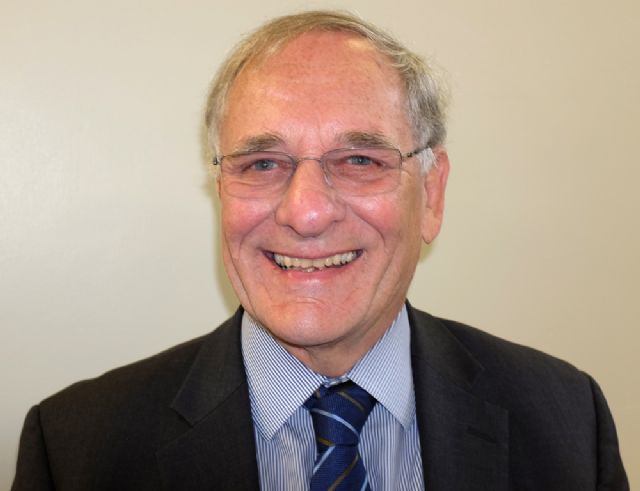
Jack Dempsey
Having been a keen squash player, Jack thought he had enough fitness to tackle the climb of Africa’s highest mountain, Mount Kilimanjaro in Tanzania. This is a dormant volcano with the last activity recorded around 200 years ago. However the molten magma is only about 400 meters under the crust at the cone. Although no technical climbing skills are required, it is still a serious physical challenge as the summit is at 19,341 feet, or 5,895 meters.
The biggest problem is AMS, Acute Mountain Sickness caused by lack of oxygen. Air contains approximately 20% oxygen but at the summit the air pressure is less than half that at sea level, meaning only half the oxygen is available for each breath! Jack went into training, and booked himself on a 10 day trip with a group of 15 other people. A large quantity of clothing was required as the terrain varied from rain forest at the base, moorland or moonscape further up, followed by arctic conditions at the peak. Plus 20 degrees at the start, to minus 25 degrees at the summit. UV radiation also had to be considered, and care of feet to reduce blisters. Each climber was assigned three porters to assist with the baggage!
The actual climb took around six days with four going up, and almost two coming down. Each day of the climb was between 10 to 15 kilometers, and varied in ascent heights. The party slept in huts, and had meals provided, plus snacks for lunch. Jack began to feel the effects of AMS from the second day, but managed to keep himself in check to not overdo the exertion. The final day was a scramble up a steep slope with volcanic scree, followed by a walk round the rim of the crater to reach the main summit Uhuru Peak. This final climb started at 11pm the previous evening to arrive at the summit for sunrise the next morning. This was to overcome the problem of melting snow on the steep ascent. Only 5 of the party from the original 15 made it to the summit, and Jack claims it was the most difficult achievement of his life! Going down was the hardest part on the feet as Jack was moving much faster and taking bigger steps. He certainly earned his certificate of achievement on climbing Mount Kilimanjaro.
At the question and answer session after the talk members asked a wide range of questions and received some very interesting answers which added spice to the talk.
Keith McIntosh gave a very well deserved vote of thanks. This was heartily and enthusiastically endorsed by all present.
Report by Peter Speirs
22 May 2019
THOSE WERE THE DAYS
Andy Paterson
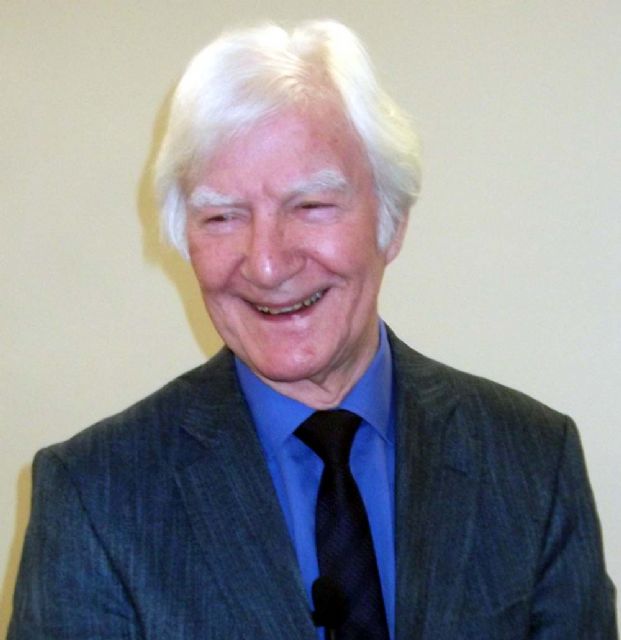
Andy Paterson
Chairman Peter Speirs welcomed 38 members to the Cupar Probus Club meeting in Age Concern on Wednesday 22nd May. The meeting opened with the usual cup of coffee and a short business session before Peter welcomed back Andy Paterson to talk about “Caricatures of Famous People”. Andy, who stays in Errol, had previously entertained the Club twice before with amusing presentations about “Stars of the Silver Screen” and “TV Times”.
Andy did not disappoint, with his slide show of caricatures covering a range of personalities. As the pictures appeared, members had to guess who they were. These covered presidents, actors and actresses, athletes, musicians, politicians, and even the Royal family. With many of the pictures Andy provided wry comments and stories in his usual droll style.
He explained that some people are more easy to caricature than others - Donald Chump (sorry Trump) appeared many times, as did Mick Jagger. The caricaturisations ranged from sketches to extremely well painted detailed pictures with some being exceedingly ugly and distorted.
Andy realised he had finished his talk rather early so much to the delight of members he presented another set of caricatures to amuse us, including some sportspersons and very early film stars. Andy then ended by asking for donations to Macmillan cancer support rather than asking for expenses. Andy has raised almost £30,000 for Macmillan by giving talks to various groups over the last few years.
After a couple of questions from members, Douglas Provan gave a heartfelt vote of thanks to Andy for an entertaining and amusing presentation, and his contribution to Macmillan.
8 May 2019
The Real Sherlock Holmes
Colin Moore
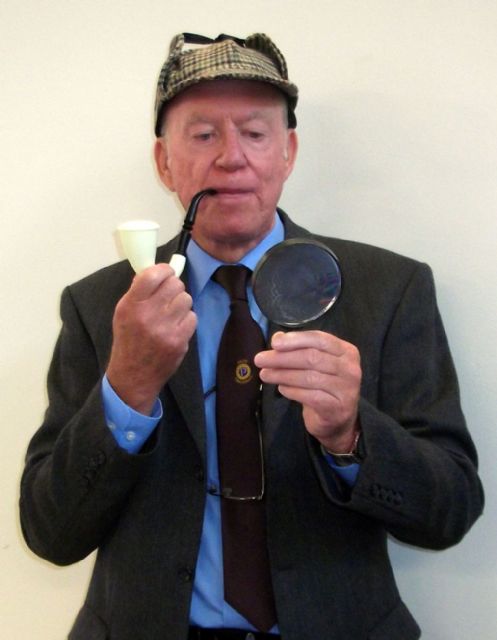
Sherlock Holmes aka Colin Moore
Chairman Peter Speirs welcomed 43 members who had braved the dreich weather to attend! Peter then introduced our speaker for today - this was our own club member and past Probus Club Chairman, Colin Moore. Colin was here to tell us about “The Real Sherlock Holmes.” Colin began by asking the audience what the fictional detective Sherlock Holmes would have looked like. He modelled for the audience a deerstalker hat, meerschaum pipe and magnifying glass which are all part of the ‘regulation kit’ used in film portrayals. He explained that these props were from the original Strand Magazine drawings but were never mentioned in the Doyle stories.
Colin took us through Doyle’s early life to his meeting and subsequent friendship with Dr Joseph Bell. He showed us through letters and a variety of other evidence how Joseph Bell had provided the inspiration for the appearance and personality of his fictional detective. He then asked for a volunteer from the audience to help demonstrate Dr Joseph Bell’s ways of forensic analysis. Chairman Peter Speirs volunteered to play the part. There then followed a mainly painless procedure which showed the audience Bell’s observational methods. Peter played his part very well and his acting skills were clearly appreciated by the audience!
Colin then took us on a journey through the Sherlock Holmes books and the real life of Joseph Bell. He showed us how fact entwined itself with fiction during the lives of Conan Doyle and Joseph Bell. Colin brought his talk up to date by showing the audience slides of five magnificent Sherlock Holmes statues around the world. Fittingly, the finest of these statues belongs in Edinburgh. This is in Picardy Place, the street where Arthur Conan Doyle was born. He ended his talk by showing the audience a slide of Joseph Bell’s final resting place in the Dean Cemetery, Edinburgh.
This talk was followed by an absorbing question time. Members asked a wide range of questions and provided some very interesting insights which acted as an excellent supplement to the talk.
Report by Sherlock Holmes
24 April 2019
THE MacDONALDS
David Caldwell
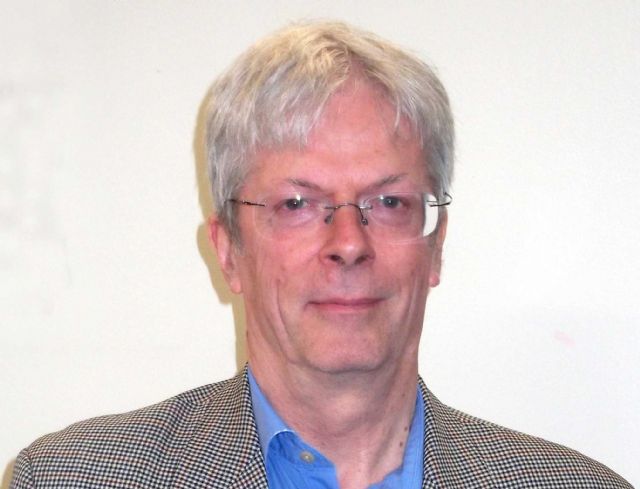
David Caldwell
Chairman Peter Speirs welcomed 44 members, and introduced Dr David Caldwell to talk about “The MacDonalds”.
David, an archeologist, was a curator at the National Museum of Scotland, led major excavations at Finlaggan, Islay, and is involved in several related organisations.
David explained that Finlaggan on Eilean Mor, Islay is the original home of the MacDonald clan. It was a very fertile area and contained precious metals such lead and silver. It was suitable for early settlement and burial grounds have been found from the 7th century.
The Lordship of the Isles laid claim to a large area of North West Scotland and the Western Isles and in the 12th century prince Somerled claimed Kingship of the Isles.
Subsequently the MacDonalds assumed Kingship. Their culture was different from Britain and elsewhere as they spoke Gaelic, were militarised, and had an army of up to 7000 men and supporting ships.
Excavations on Eilean Mor have revealed the remains of early timber defences, a midden on the bottom of the loch, a stone keep, kitchens, a late 14th century chapel, houses between the 12th and 16th century, roads and a council chamber. Various finds included arrowheads, keys, a pilgrim badge, and many other items.
David explained that Finlaggan was at the height of power in the 15th century when there were lots of buildings evident. Documents such as the 1549 Laws of Ranald, son of Somerled, indicated that there was a Finlaggan parliament similar to the 12th century Tynwald of the Isle of Man and Shetland’s Tingwall, although it is not clear which came first. The power and culture of the MacDonalds spread into other part of Scotland leading to “Scottishness”, although the title “Lord of the Isles” was taken away from the MacDonald family by the Scottish parliament in the 15th century.
David answered several questions from members covering shipbuilding, the source of timber, and the Clan MacDonald centre on Skye, after which Mike Edwards gave a vote of thanks for an informative, detailed, fascinating and well-illustrated talk.
Report by John Topliss
10 April 2019
STONEMASONS' MARKS
Andrew Johnson
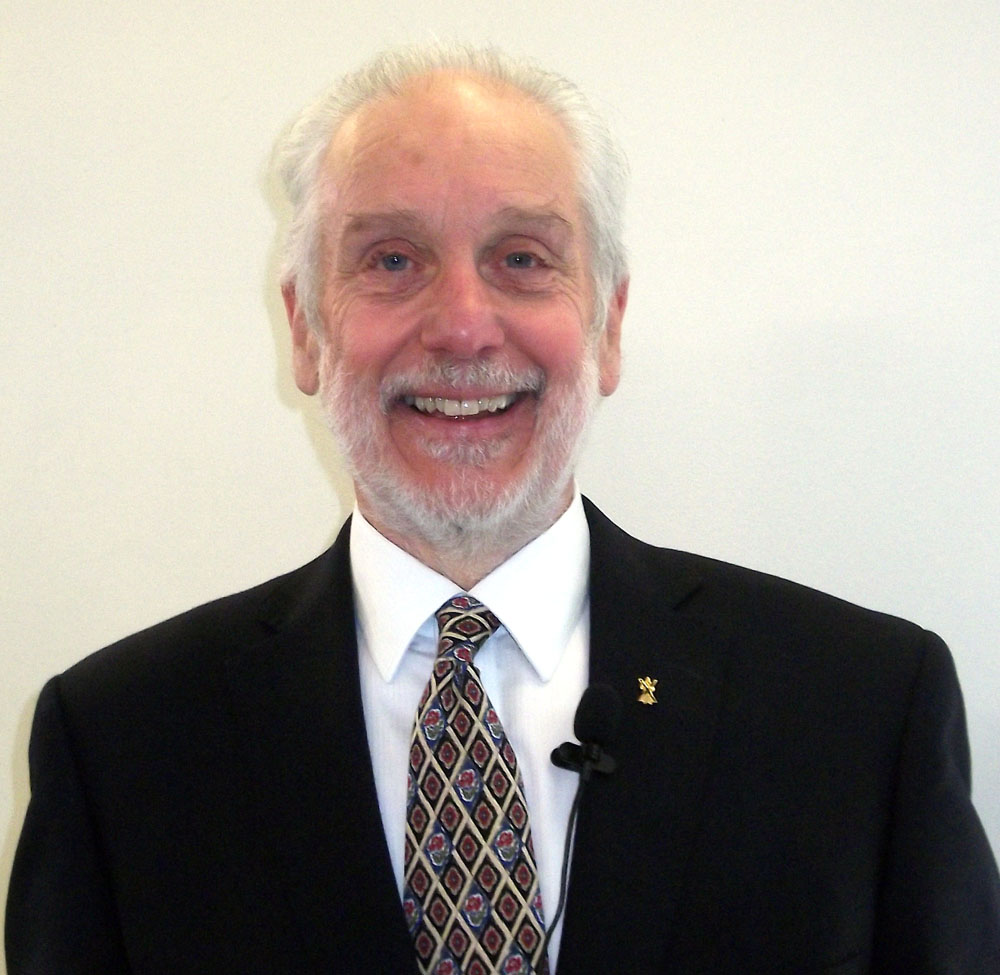
Andrew Johnson
Chairman Peter Spears introduced our speaker for today, Andrew Johnson, a Trustee of St Andrews Preservation Trust. Andrew was here to tell us about “Stonemason’s Marks.” Andrew began by explaining that mason’s marks can be seen in all of our old buildings. An apprentice would serve under a registered mason for six to eight years. Once he became certified a personal mark was created and registered in his name. This mark could be a combination of his initials or a unique logo of his choice. He would then use this mark on his stones for the rest of his working life. When qualified he could travel the country working as a Journeyman mason. Andrew then went on to show us examples of marks found in various parts of Fife. Starting in St Andrews and the St Rules Tower, he took us on a journey to the cathedral undercroft and through to the old entrance of the ByreTheatre. Then onto various other Fife locations at Balmarino Abbey and Dunkeld Cathedral. Matching mason’s marks show how journeymen masons travelled the length and breadth of the country plying their trade in our great cathedral and churches. One mason’s journey can be followed from Durham through to Dunfermline and on to Dunkeld. The best place to view mason’s marks is on doorways, fireplaces and arches, rather than on rectangular blocks of stone. This is because the marks on stone slabs were often obscured by the builder as they thought that they disfigured the finished stonework. Some of our grand historical buildings gave specific orders that marks should not be visible on the completed walls. From our great cathedrals and castles to small churches and bridges, stonemason’s marks survive through the centuries as a testament to their incredible work. They are window into the past. This fascinating talk was followed by an extensive question time. Then Peter Speirs gave a very well deserved vote of thanks. This was heartily and enthusiastically endorsed by all present.
Report by Colin Moore
27 March 2019
THE LIGHTHOUSE
Jane Crockett
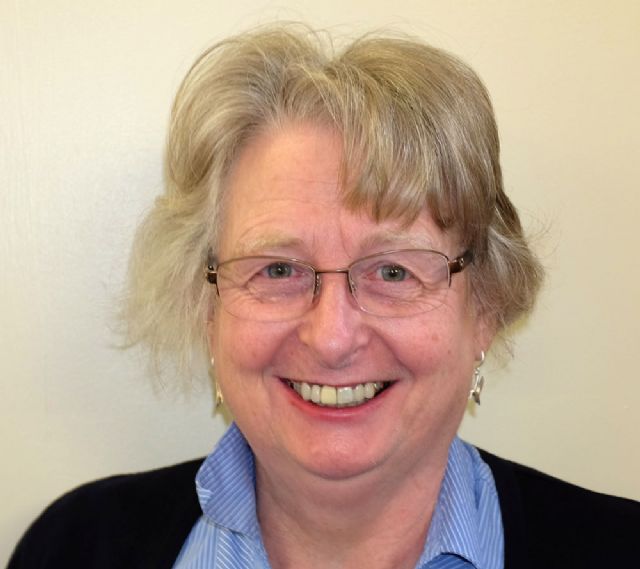
Jane Crockett
Cupar Probus Club met at Age Concern, Cupar on Wednesday 27th March, when Chairman Peter Speirs welcomed 41 members. After the short business session Peter introduced the speaker for the day, Jane Crockett from the Cupar Lighthouse. Jane started by announcing that her most recent Probus Club audience had at first assumed she was a pharologist, who would talk about actual lighthouses. We in Cupar know better having had the Christian book and coffee shop in Bonnygate since 1987.
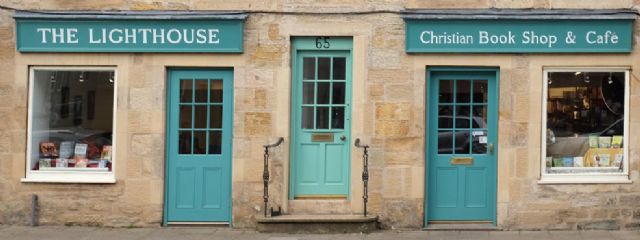
The Lighthouse, Bonnygate, Cupar
At that time Morag MacGregor a member of Cupar Old, Christine Sawyers of St John’s, and Rev. Bill Macdonald the new Baptist minister conceived the idea of a community café where locals could meet for chat and church resources would be available. From the start it was an ecumenical project with staff and volunteers coming from all the churches in Cupar and the surrounding districts. Money for the project appeared remarkably quickly aided by an auction which lasted till the wee small hours and raised £18,000. Jane explained that prayer for funds was regularly answered with ready financial support from church members both individually and by organizing fund raising concerts together with grants from various local schemes and trusts. The most obvious use of such funds can be seen in the beautiful restoration of the shopfront in 2017. In 1987 the new minister of Cupar Old, Derek Browning, had attended the opening as the Lighthouse’s first chairman; thirty years later he returned as Moderator of the Church of Scotland for the official reopening. Apart from providing homemade food, books, and greetings cards it had always been meant to be a refuge for needy and lonely people: the tramp who required food and socks, the old actor whose child was a Hollywood A-lister, the drug addict who with local support eventually ended up as a pastor in New Zealand with a wife and family. Christian bookshops have been closing all over the country in recent decades while far more cafés and eating places have been opening and shutting in Cupar but the Lighthouse has bucked the trend. Jane paid proper tribute to staff and volunteers over the years. She did study business at university and in her early career managed a large branch of Mothercare but the warmth and enthusiasm of her talk as well as the sympathetic and friendly style of its delivery did more to explain her success as manager. Following a short question and answer session, John Topliss proposed the vote of thanks, and the applause was well deserved as her talk was very warmly received by its audience. A collection was taken on retiring and a sum of £178 was handed to Jane to help with the good work the Lighthouse does in the community.
Report by David Cleland
13 March 2019
INSIDE UEFA
Scott Struthers
Chairman Peter Speirs, today welcomed Scott Struthers, a UEFA match delegate to talk about his role in inspecting UEFA Cup games before, during and after each match. Scott explained that he was one of 15 delegates responsible for carrying out inspections at the 2300 UEFA games played each season.
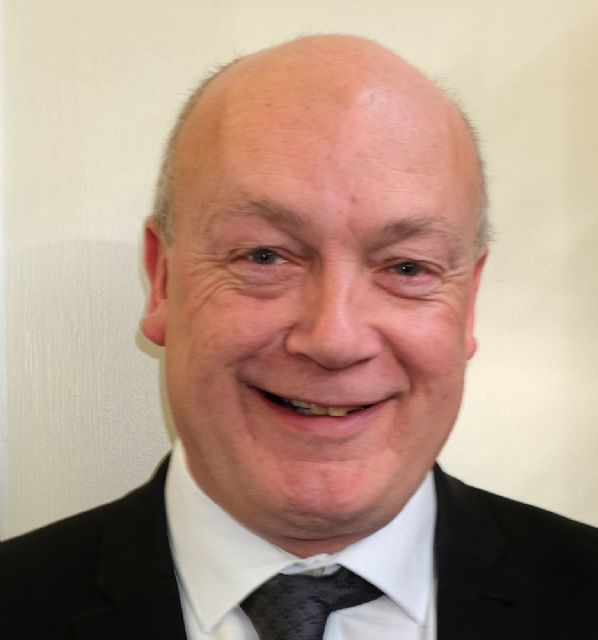
Scott Struthers
Scott has had a long background in football including being secretary of Hamilton Academicals, on the Scottish FA Disciplinary Committee, and other roles before becoming match delegate. He explained, however, he had never been a football referee except at school.
6 weeks before a game, which could be anywhere in Europe, he would start the planning with stadium reports, problem areas, logistics of travel (especially eastern Europe), and team information. Arriving at the site Scott would look at the stadium and check out the facilities including making sure the Wi-Fi was available. This is essential because all UEFA matches are coordinated to start at the same time and are watched live on screens in UEFA headquarters in Switzerland.
On the morning of the match there would be a pitch inspection, check that the VAR (Video Assistance Referee) is working, and ensure that playing kits are OK. The security arrangements would be checked with special attention if there could be potentially political or racial tensions between teams and fans.
Scott pointed out that some symbols are not acceptable in all European countries which can cause problems. Apparently, the Celtic Cross is not allowed outside Scotland and Ireland, and Nazi symbols, which may be acceptable in parts of southern and eastern Europe are banned elsewhere. The flag of the Turkish Republic of Northern Cyprus has caused problems because that country is not recognised by any other country except Turkey.
During the match Scott has to watch the action in the stands to ensure that any problems are dealt with properly. Fans are searched before the match but they still manage to smuggle in flares and smoke bombs which can be as small as a ballpoint pen. Apart from the obvious distraction of these devices they can cause fires and serious injuries. When the match is over Scott still has to write his report before catching his plane home.
Scott finished his talk with a few stories about problems travelling to and from matches in the Faroe Islands. He then answered some searching questions and a well received vote of thanks to Scott was given by David Galloway for an interesting and informative talk.
Report by John Topliss
27 February 2019
THE CARL ROSA STORY
Iain Fraser
Chairman Peter Speirs introduced Club member Iain Fraser, as the guest speaker for the day.
Iain followed up his previous talk on opera in Scotland with a fascinating account of the life of Carl Rosa who started as a child prodigy on the violin and then became an impresario who founded a highly successful company that produced operas in English.
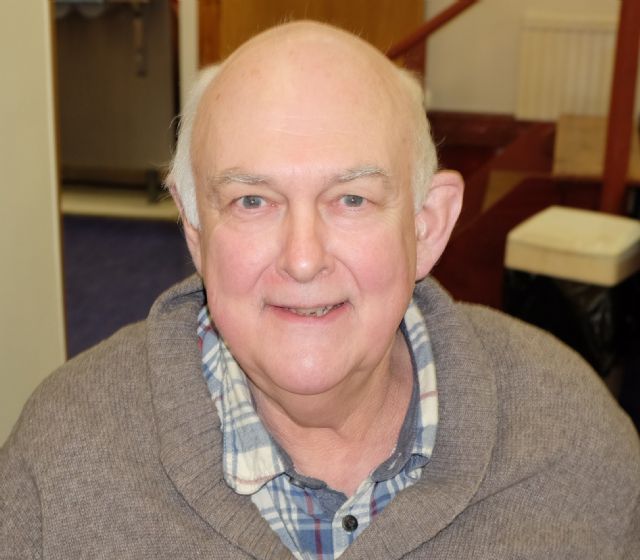
Iain Fraser
Karl Rose was born in Hamburg in 1842; he later Anglicized his name as Carl Rosa, though interestingly his surname was given as Rosi in advertisements for his concerts in Edinburgh in the 1850s. After Mozart child prodigies throve and Rosa toured Germany, Denmark, and Britain. He played at the Kinnaird Hall, Dundee (forerunner of the Caird Hall) during the Burns Centenary celebrations of 1859. He led the Hamburg Philharmonic at 21. Five years later he married the greatest soprano of the age Euphrosyne Parepa: she was born in Edinburgh to a Scottish mother and a noble Romanian father. Rosa had travelled with her to New York as a violinist and they married there. They crossed to San Francisco and put on the first opera seen in the city. It was the difficulty of managing such a tour that turned the performer into the impresario and together they set up the Parepa-Rosa English Opera Company.
After touring as far as Cairo they established themselves in North West England. Sadly Euphrosyne died in 1879 aged 37, from complication following her third stillbirth. Rosa took up with his leading ballerina, aged 19, and they had four children in a common law marriage. He had relaunched the company performing only operas in English whose performances- 240-290 a year at twenty plus venues - were far more frequent than any opera company’s today and attracted huge audiences: one winter gardens performance had an audience of up to 11,000. He was a shrewd and successful businessman having for example exclusive rights to the English translation of Carmen. He became a household name and a wealthy man.
He died in Paris in 1889 and his funeral was an international occasion. The company continued under his wife Josephine and, after her death in the 1920s, on till 1960. The government was helping to fund opera and favoured the London based Sadler’s Wells over a company from Liverpool. Iain’s excellent talk showed how Carl Rosa was the greatest influence on opera in Britain in the 19th century.
A few well chosen questions and comments were heard before Colin Moore gave the vote of thanks.
Report by David Cleland
13 February 2019
LOCAL HISTORY IN STONE
Bruce Manson
Chairman Peter Speirs welcomed Bruce Manson to talk about “Local History in Stone”. Bruce, who is from Markinch, explained that he is an amateur archaeologist who specialises in ancient stones found in the Markinch area.
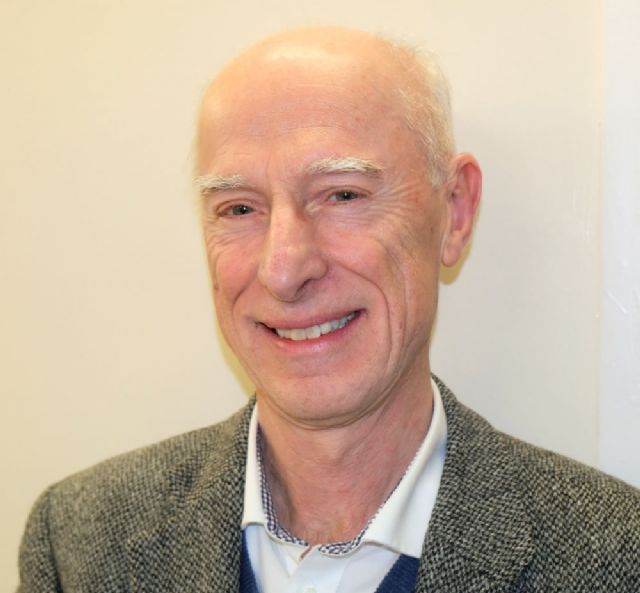
Bruce Manson
Stones for building survive in the Scottish climate where timber structures rot away. Some areas without trees such as Orkney and Shetland have only stone buildings left.
Stonehenge is an example of a henge (a ditch surrounding a circle of monuments). There is a henge at Markinch, but the timber monuments have disappeared.
Bruce showed photos of a series of ancient stones used for different purposes such as symbolic, practical, or decorative. These included arrow sharpening marks, marriage stones, boundary stones, imported millstones, and an imported marble tombstone.
The Markinch church tower was made of 8000 sandstone blocks between 1120 and 1130 when Markinch was the centre of Fife on the pilgrimage trail between Dunfermline and St Andrews. The nearby Moot Hill was also an important location before power moved in the 13th century to the Moat Hill in Cupar.
800 distinctive mason marks were found on the Markinch church tower ranging from mason identification to detailed building instructions. Recent archaeological excavation by the Markinch group has revealed scaffold holes and old building work. 19th century restoration work on the tower used low quality sandstone which has eroded and has had to be replaced.
In the reformation in 1660 buildings were “simplified”. This involved chiselling away any religious images such as crosses and crucifixions leaving vandalised structures, which can be seen today. Even Celtic crosses were removed.
Bruce finished his talk by showing a border stone he has made for his garden with a large “M” on it for his name, Manson. He suggested that this would have a longer permanence than the electronic records that are created today.
After Bruce had responded fully to several questions, Allan Black gave a well received vote of thanks for Bruce’s fascinating and well illustrated talk.
23 January 2019
SONGS OF THE PEOPLE
Alistair Macfarlane
Chairman Peter Speirs gave a warm welcome on a very cold morning to 44 members and 1 visitor. Chairman Peter introduced our speaker for today - this was the local musician Alistair Macfarlane. Alistair’s chosen subject was “Songs of the People.”
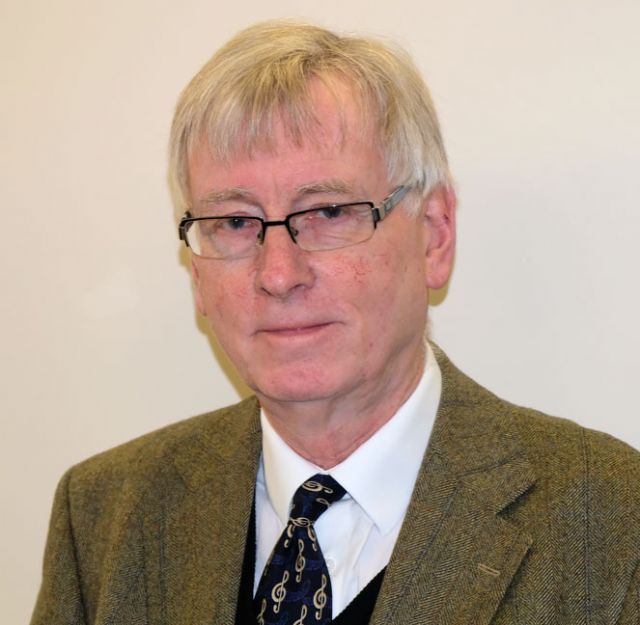
Alistair Macfarlane
Alistair explained that his talk was about how folk songs give a keyhole view of past people and their place in our history. He then set about showing us how folk songs are a vital link to the past and illustrate how ordinary people lived their lives in various parts of the UK. Folk songs passed down to us by previous generations show us long ago ways of life that would otherwise be forgotten.
Alistair started with a haunting lament sung by a group of Durham pitmen coming home from their backshift and looking back on their hard lives in the old coal pits of the North. Then he took us up to Dundee and everyday life in the Jute Mills of that city. He played us three recordings by Mary Brooksbank, including, “The Dundee Lassie” telling us of the travails experienced by the bobbin spinners. Then he moved on to talk about the songs left to us by travellers. He illustrated these with a series of songs passed down through the ages, including “The Times they are a Changing”. He then talked to us about the well known traveller, Jess Smith and the rich heritage of songs and stories that she has given us. This was followed by two haunting songs about Selkies, sung by Julie Fowlis.
>Alistair concluded his talk with some audience participation. He encouraged members to join in with the chorus of a famous Julie Fowlis folk song called “Fodder for the Small Stirks”. The quality of the audience participation may not have reached a perfect pitch, but this lacking was more than made up by the enthusiastic tones reverberating around the room!
This was a fascinating talk that kept members spellbound throughout. He gave a wonderful snapshot of past people, their hopes and expectations all through the medium of the folk music left down to us over the years.
This talk was followed by several interesting questions.
Bob Farmer gave a very well deserved vote of thanks, which was heartily and enthusiastically endorsed by all present.
28 Nov 2018
THE EYEMOUTH DISASTER
Bert Oliver
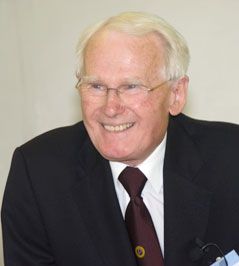
Bert Oliver
The Chairman, Colin Moore, welcomed Bert Oliver, a longstanding member of Probus, to talk about the Eyemouth disaster. Colin explained that Bert was standing in at the eleventh hour for Alan Hutchinson, the General Manager of the Tay Road Bridge, who had been called away at short notice.
Bert started by outlining the situation at Eyemouth, a fishing village in Berwickshire, on Friday 14 October 1881, now called Black Friday. Dozens of fishing boats went to sea on a calm day to get to the fishing grounds 15 miles out. They were manned by men and boys from Eyemouth and neighbouring villages. Some of the boys were only 11 years old.
A great storm, or hurricane, suddenly blew up and the boats either had to get to deep water or try to get to back to shore. Bert then explained in great detail the situation the fishermen faced as the wind rose rapidly. Boats were swept ahead of it, sails shredded. On shore 63,000 trees were lost near Duns.
Some boats were overwhelmed and the fishermen drowned. Boats reaching the harbour were smashed on the infamous Hurkar Rocks at the harbour entrance. The harbour itself was tidal and empty. Some boats tried to beach, usually unsuccessfully. Those boats that had ridden the storm often suffered the same fate later. Meanwhile fathers, wives and mothers grieved on the shore as their men folk and sons were lost in front of their eyes.
Out of a population of 800/900, Eyemouth and the area had lost 189 men and boys, but only 47 bodies were ever found. The remaining families had to recover and rebuild for the future. Today Eyemouth is a flourishing fishing village once again. Bert is emotionally tied to Eyemouth as he was brought up there and 17 of his ancestors, all from the Collin family, died in the horror of Black Friday, which is why Bert’s full name is Robert Collin Oliver.
There was a centennial remembrance service in 1981, but on 14 October 2016 a 5 metre long sculpture was unveiled near the harbour depicting all the bereaved widows and children of Black Friday. This has a special meaning for Bert.
After several questions, member Will Mackay gave a thoughtful vote of thanks to Bert for providing such a detailed, interesting and personal account of the disaster at such short notice, with which the members wholly agreed.
Report by John Topliss. Photo by Peter Speirs
14 Nov 2018
MY SINGING YEARS
Anne Baird with Bela Simandi
Today's meeting was held in the Cupar Old Parish Centre where Chairman Colin Moore introduced our guest performers for the day, Bela Simandi and Anne Baird.
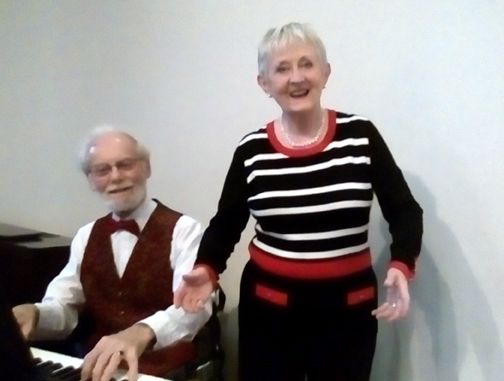
Bela and Anne
Bela originally came from Hungary before becoming a professional musician at the Royal Conservatoire of Music in Glasgow. He then pursued a career as a recitalist and accompanist in his own right. Anne Baird has enjoyed an all consuming interest in music throughout her life. She became a member of the Sadlers Wells Chorus in London and then became a soloist with Scottish Opera. She then successfully ran “Opera for Youth” and “Opera Go Round”, touring Scotland.
On a dreek grey and wet morning Anne and Bela lit up the hall with a delightful programme of music and song, which they called “Light and Bright.” Anne sang a variety of light opera pieces mixed with a selection of songs from West End musicals. These included “On My Own”, from the blockbuster musical, “Les Miserables” and a wonderful medley from "South Pacific". These were all impeccably accompanied by Bela on his electric organ.
Bela also played several solo pieces including a delightful rendition of the haunting “Third Man” theme tune.
Club members listened with pleasure throughout and needed no encouragement when asked to join in the chorus of some of the songs.
Colin Moore gave a most appreciative vote of thanks at the end of this wonderful performance. This talented duo had put everybody into a cheerful frame of mind on what weather wise was a particularly cheerless day.
Club members left the hall, back into the rain and the wind, happily humming and whistling snatches from the show. This had been a special morning’s entertainment from an especially talented couple.
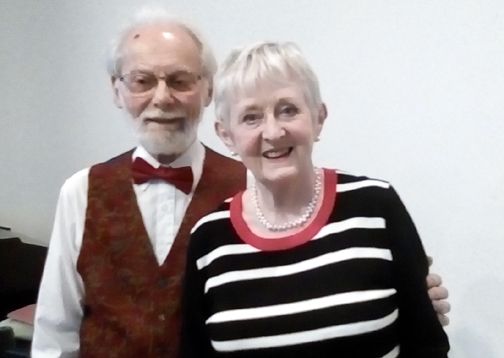
Thank you both
Report by Colin Moore. Photos by Peter Speirs
24 Oct 2018
POPPY SCOTLAND
Jodie Whitham
Chairman Colin Moore introduced Jodie Whitham, the Regional Fund Organiser for East Scotland’s Poppy Scotland Appeal. Jodie had travelled to us from Edinburgh and was warmly welcomed by members.
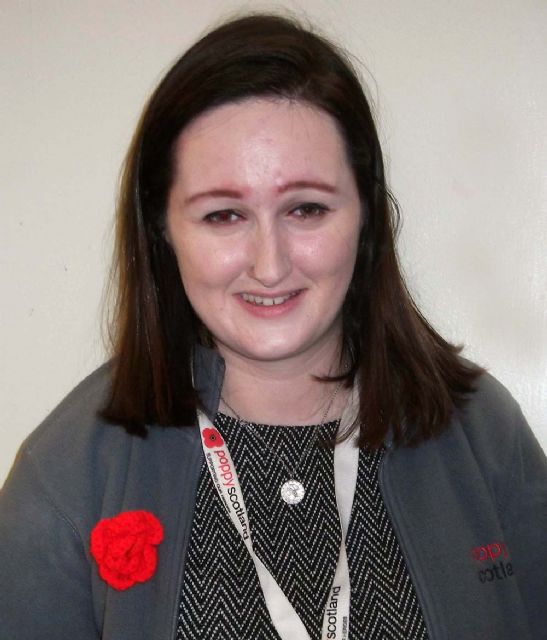
Jodie Whitham
Jodie explained that poppies grew in profusion on the mud covered battlefields after the shelling of the First World War and poppies were chosen as the symbol of the fallen. Earl Haig started the first poppy factory in Richmond, Surrey in 1922. Subsequently Lady Haig designed the Scottish poppy and in 1926 opened the Edinburgh factory.
Today there are 39 veterans making poppies by hand in that factory. They also make wreaths including some for the Royal Family. Apart from our own Scottish poppy, there are different poppy designs available. For example, the English poppy has two petals and a leaf. Jodie showed a short video starting with shots of the First World War and then the Edinburgh factory with some of the veterans making poppies on the traditional machinery.
Jodie reminded members that one million British soldiers, sailors and airmen were killed in that war and one and a quarter million were left disabled. She then read the poignant poem, “In Flanders Field” by Lt Col John McCrae.
She then explained that Poppy Scotland provided support to ex – service personnel in several key ways, especially with mental health and physical disability. Poppy Scotland provides funding for the Armed Services Advice Project which has helped over seven thousand veterans back into employment.
Jodie pointed out that the Scottish Poppy Appeal is the largest fund raiser in the UK and raises over £2 million a year. The fund raisers consist of 500 area organisers and over 10,000 collectors. They are nearly all volunteers!
After Jodie’s talk there was time for club members to ask questions and add comments. At this point Bob Farmer highlighted all of the upcoming commemoration activities taking place in Cupar.
Then Robin Thomson, gave a well delivered vote of thanks. This was heartily endorsed by all club members. Then Jodie opened up her sale of poppy merchandise stall. Members collected around her table, where a variety of poppy designed broches were for available for sale.
A sum of £136 was donated by members.
Report by John Topliss. Photo by Peter Speirs
10 Oct 2018
QUOTE... MISQUOTE
Colin Moore
Having chaired the club business for the day, Colin Moore transformed from Chairman to Speaker for the day to deliver his talk entitled “Quote.. Misquote!”
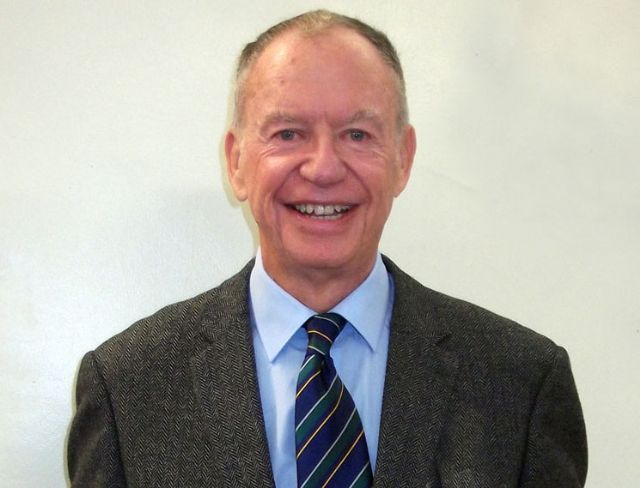
Colin Moore
This turned out to be a light hearted and amusing talk about famous quotes, misquotes, ripostes and jibes, slogans and catchphrases. Colin began by explaining that a quote is a short statement that we remember and think worth repeating. This could be because it is – worthy, funny or wise. Some quotes have been corrupted over the years by accident or design. These are called misquotes. A well-known quote or misquote spoken at just the right time can really hit the spot.
Colin’s talk began with a look at famous first lines of novels. Then he moved on to space travel, mentioning Neil Armstrong’s “Mr Gorsky” misquote. He told us about three blond actresses, Mae West, Marilyn Monroe and Dolly Parton, who all mocked themselves using funny quotes as a defensive barrier. He then raised further laughter with a range of sporting quotes, from famous cricketers, golfers and footballers.
He demonstrated that the Bible and Shakespeare were the most quoted and misquoted texts in the English language. Then he moved on to the murky world of politics, scrolling through amusing blunders, ripostes and jibes made by Winston Churchill and his ilk. He concluded his talk with a look at quotes and misquotes made in the modern world of the text, the tweet, hashtag and snapchat.
After Colin’s talk there was time for club members to add some of their own treasured quotations. Then club member Ron Campbell gave the vote of thanks, throwing in some funny one liners of his own into the mix. He thanked Colin for a splendid morning of amusing entertainment.
Report by Colin Moore. Photo by Peter Speirs
26 Sept 2018
A W WHITLEY
Ron Campbell

Chairman Colin introduced our own club member Ron Campbell as our speaker for today. Probus member Ron Campbell continued with his excellent series of talks on air force history by describing the history both of the Armstrong Whitworth Whitley bombers and of its crews. In 1930 bombers had changed little from the end of the war and were biplanes with open cockpits. By 1937 when the first A.W.Whitley entered RAF service it was a monoplane with much stronger engines and tail and nose gun turrets. In September 1939, it participated in the first RAF raid upon German territory, though during the Phoney War only leaflets were dropped, some as far as Poland and Czechoslovakia. When actual bombing began 'planes were much hindered by primitive navigation with some missing their target by 50 to ten miles. Dropping zones were dictated by ETA (Estimated Time of Arrival). On one occasion due to bad weather the Thames was mistaken for the Rhine and bombs accordingly dropped on the nearest airfield. Luckily all missed their targets. The age of pilots must always be remembered: one finished his first tour of duty (30 flights) the day before his nineteenth birthday. Among famous pilots we heard of Willie Tait who helped sink the Tirpitz in 1944 and succeeded Leonard Cheshire as commander of the “Dambusters” squadron; uniquely he was awarded the DSO (Distinguished Service Order) four times. Hamish Mahaddie rose from apprentice ground crew to Group Captain and on retirement organized acquiring of planes for many films including The Battle of Britain. The Whitley's last usage as a bomber was in 1942 but it later served with Coastal Command and also towed gliders. It dropped secret agents and matériel into occupied France. Briefly it flew for BOAC but the Gibraltar to Malta run was too hot and the flights to Sweden too cold. It also served in military exercises including a much concealed disaster when two 'plane loads of paratroopers landed in the Tay rather than Tentsmuir due to high winds. The last Whitley was scrapped in 1949. As part of Bomber Command it undertook 8,996 ops, dropped 10k tons of bombs, and lost 269 aircrews. Of the 1,812 bombers built, 25% were lost. At the conclusion of this excellent talk, Peter Speirs gave a warm and appreciative vote of thanks to Ron on behalf of the club members.
12 Sept 2018
THE ASSASSINATION OF PRESIDENT GARFIELD
Martin Hepworth
Dr Martin Hepworth, a retired GP, has given more talks to Probus than any other of our speakers.
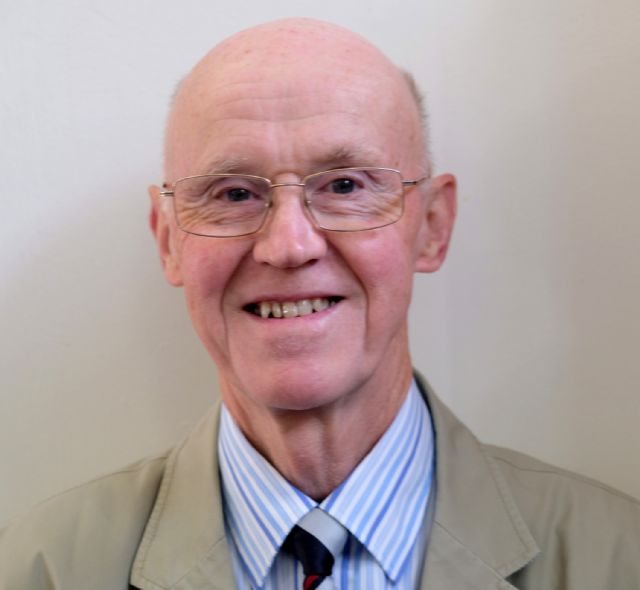
Dr Martin Hepworth
Having talked on Scottish banknotes, Laurel & Hardy, the Klondyke Gold Rush, and the Preston Bank Scandal he now provided a fascinating talk about the assassination of President Garfield. While our members could undoubtedly recall what they were doing when they heard of John F. Kennedy's killing and knew about Lincoln's evening at the theatre they were probably vaguer about the deaths of the two other assassinated presidents , James Garfield and William McKinley.
After hearing our guest they are now much more knowledgeable about both the life and the death of Garfield (1831-1881). Like Lincoln, Garfield went from log cabin to the White House; son of a poor farmer's widow he funded his later teenage years of education by being the school janitor. Then after teaching in the school within ten years he was a college professor of maths and classics.
He became an Ohio senator in 1859 and entered Congress during the Civil War during which he rose to the rank of general in the Union Army. A skilled orator, he was chosen as Republican presidential candidate in 1880 and on winning the election attacked patronage and corruption in civil service appointments and spoke up for ex-slaves' civil rights. Four months into his term he was shot in a Washington railway station by Charles Guiteau an unsuccessful lawyer and evangelist who believed he should, despite knowing no French, be appointed ambassador to France. Despite American doctors' knowing about antiseptic treatment from Joseph Lister at the 1875 Centennial Exhibition they rejected its use and after 79 days Garfield died of sepsis, Such was the strength of public feeling that Guiteau though undoubtedly insane, was executed. Vice President Chester Arthur succeeded. Although at first despised and indeed suspected of being involved in the assassination he reformed the civil service and broke the power of the political boss whose protégé he had been. When Arthur left office after one term he was generally respected.
Garfield's daughter Mollie married her father's young secretary Joseph Stanley Brown who later became one of the founders of the National Geographic Society
Report by David Cleland. Photo by Maurice Shepherd
25 July 2018
RECYCLED TEENAGERS
Roger Stark
Chairman Colin Moore introduced our special guest speaker Dr. Roger Stark who spoke of “Methuselah and The Recycled Teenagers.”
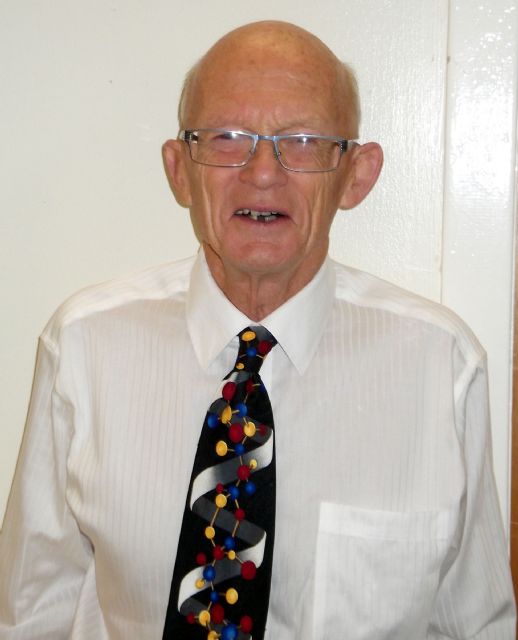
Roger Stark
It soon became apparent that the assembled audience were the recycled teenagers! Roger started his talk by explaining that old age is a state of mind.
People are now living much longer than previous generations. Older people are part of society’s success story. Several hundred years ago life expectancy was between twenty five and thirty years. Although talked about now in negative terms, food processing and refined foods were great inventions stopping people dying from food poisoning. Society only started to understand about vitamins and the food pyramid in the early twentieth century.
We now live longer thanks to a better understanding of dietary needs and better health care. We are now helped by safe blood transfusions, limb repairs, stents, etc. Life expectancy has changed dramatically. Statistics show that there are now two thousand centenarians alive in the UK, compared to only forty fifty years ago.
Roger then went through his regime for extending one’s life span. This ranged from advice on diet, medicines, and having a happy contented lifestyle. Roger’s talk was complemented with very funny visual slides and cartoons together with a humorous musical soundtrack. The conclusion of his talk was followed by a wide range of very interesting questions and comments from the audience. After question time, club member Robert McCririck, gave a most appreciative vote of thanks, heartily endorsed by our club members.
This very upbeat and entertaining talk concluded our club meetings before our annual August break.
Report by Colin Moore. Photo by Peter Speirs.
11 July 2018
VANISHED LOCH ROSSIE
David Munro
Chairman Colin Moore introduced our special guest speaker, Professor David Munro.

David Munro
Professor Munro, formerly director of the Royal Scottish Geographical Society, gave a most interesting talk about the vanished Loch Rossie. Although many of us would have known that the local name “Kinloch” is Gaelic for “head of the loch” (and being aware that Birnie & Gaddon are under thirty years old), we have learnt that the vanished loch is Rossie Loch.
Known historically since the 1400s it is still present in the name of Rossie House and Estate off the A93 between Collessie and Auchtermuchty. “Rossie” means “promontory” and this was the land jutting into the other end of the loch. With the help of maps beautifully drawn since the 1590s and printed from mid seventeenth century on our speaker showed how successive generations of landowners had drained the loch to improve both cultivation of land and livestock and the ease of travel. Such drainage started in the early 1600s and can be clearly seen e.g. in General Roy's military survey after the '45 . A 1775 map reports the loch is drained and in 1805-6 the inhabitants of Kinloch village were dispersed to the new settlements of Edenstown, Giffordtown, and Monkstown (now part of Ladybank).
No sign of such change can now be seen when driving on the A93 but the speaker explained where various lengthy drains might still be found. Local farms too retain names derived from the water e.g. Kilwhiss (Gaelic: “projecting into loch”) or Daubs (Scots: “mud farm”). The talk ended with accounts of two other such local drainings. At Lochore the loch had disappeared in the late 1700s only to return in the 1920s with subsidence caused by mining from 1902 on and now features as part of the country park. Then in 1794 the local laird attempted to drain Loch Leven but it was too great a challenge which understandably bankrupted him though the 5,000 acre loch was eventually reduced by a quarter and the RSPB have been reintroducing wetlands at Vane Farm. Prof. Munro opened members' eyes to what they can no longer see in a fascinating lecture.
A vote of thanks was given by Roddy MacLeod.
Report by David Cleland. Photo by Peter Speirs.
27 June 2018
ROLLS ROYCE ENGINES
Jim Tebbs
Chairman Colin Moore introduced our special guest speaker, Jim Tebbs, to talk about Rolls Royce engines.
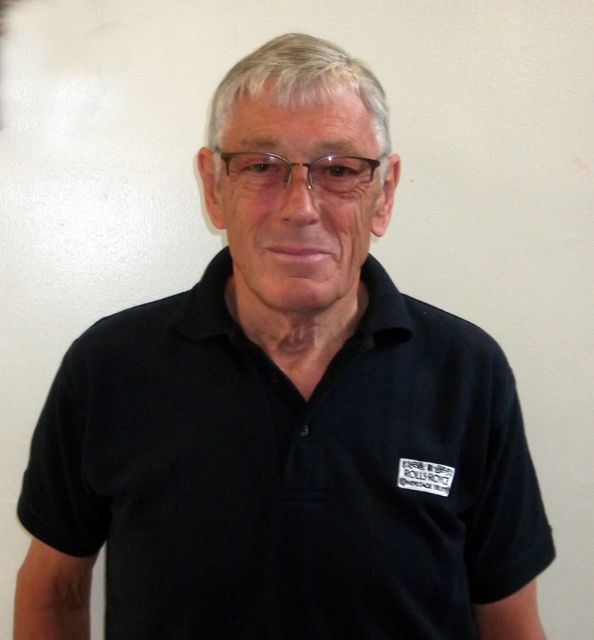
Jim Tebbs
Jim began by telling us how in his early career, he had worked for the Rolls – Royce Flight Test Establishment in Hucknall. He worked on the development of control systems for the large fan engine blades. He moved away from the company in 1978 spending the rest of his working life in various areas of the Automotive and Aerospace industry. On retirement in 2008, he was invited back to Rolls – Royce joining the Rolls – Royce Heritage Trust. This has a particular mandate to protect the history and engineering excellence of the company.
Jim used a well organised presentation with slides and photographs to plot the lives of the two great founders of the company. These were Sir Henry Royce OBE and the Hon Charles Stuart Rolls. He outlined for the audience the many significant milestones they shared together in the early part of the twentieth century. All based on the growing public interest and demand for motoring and powered flight. They were at the cutting edge of what was then a boom industry.
Unfortunately, CS Rolls, a flying enthusiast in his own right, was killed when a Wright brother’s plane that he was piloting crashed in 1910. This cruelly severed the partnership but not the reputation of the company. Henry Royce went on with Rolls – Royce and manufactured some of the finest automobiles and aero engines ever developed.
Jim gave an enthralling account of the partnership that developed between Rolls – Royce and RJ Mitchell of Supermarine. This joint activity led to Britain winning the prestigious Schneider Trophy in 1931 and more importantly to the development of the Spitfire which was vital to our victory in World War Two. The two men died prior to the war. They were unable to witness the finest hour of their achievements during the Battle of Britain.
After the war Rolls – Royce built on the successful work of Sir Frank Whittle by developing a full range of jet engines. Jim gave a fascinating account of the range of jet engines and the way that the Aerospace Industry was able to consolidate their success with Concorde and the Lockheed Tristar programme. Jim ended his talk by bringing us up to date on the future which now faces Rolls – Royce after more than 110 years of engineering excellence.
There was then followed by an interesting question and answer session. Club member John Topliss, gave an appreciative vote of thanks, on what had been a fascinating and well produced talk.
Report by Colin Moore. Photos by Peter Speirs.
13 June 2018
CHARLES LEE, ARTIST
Roddy Greig
Chairman Colin Moore introduced our special guest speaker, Roddy Greig, to talk about Cupar born artist Charles Lees.
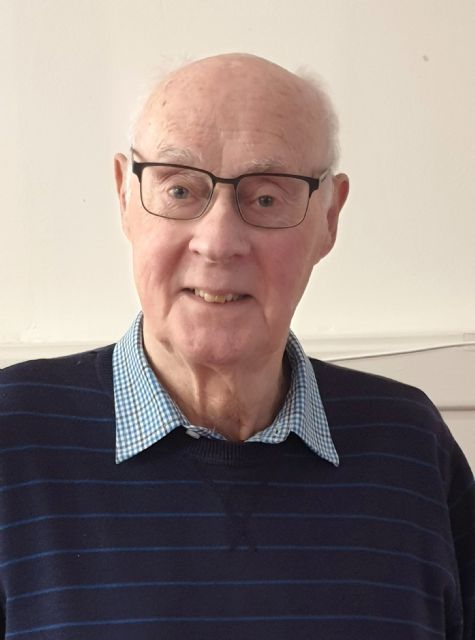
Roddy started his talk by showing us a picture of “The Golfers.” This is probably the best known work of Charles Lees and is in the National Galleries, purchased at a cost of £2 million.
Roddy knew nothing much about art or Lees, so he decided to do some genealogy and research. This became a consuming paper and archive hunt through the footprints of history as Roddy painstakingly collected evidence about the life and times of Charles Lees from a wide range of sources.
He discovered that Charles’s father was a linen manufacturer and had moved to Cupar in 1785. Charles was born in Cupar in 1800. Charles was always good at drawing and painting. He applied to join the Drawing Academy, the forerunner of the National Galleries. He was finally admitted in 1830 with Sir Henry Raeburn standing as one of his supporters.
Charles’s love life got interesting when he taught drawing to eighteen year old Elizabeth Christie. Her father did not appreciate the attentions that he was paying to his daughter and she was made a ward of court. However, Charles eloped with Elizabeth to Gretna Green where they were married. A warrant was subsequently made out for his arrest and he ended up in Fleet Prison for defying the court order. This was eventually sorted out amicably and the couple proceeded on the Grand Tour through France, Switzerland and Italy, where their first son was born in Rome. He was the first of nine children.
Charles’s father had stocks in the City of Glasgow Bank and Charles inherited these on the death of his father. Unfortunately the bank collapsed and Charles became liable to repay a large sum of money. This difficulty haunted him for years. He died in 1880 and his gravestone is in Warriston Cemetery, Edinburgh.
Charles Lees has his paintings exhibited in several major galleries around the U.K. Roddy showed us a few family portraits as well as some portraits and early photographs showing Charles at different stages of his life. Among these was a portrait done in Rome in 1833 by Academician Robert Scott Lauder.
Roddy showed us around some of the documentary evidence that he has unearthed relating to the life and activities of Lees. He admits to having become quite immersed in the subject and has actually purchased three Lees paintings which are on loan to Cupar Heritage Centre.
After question time, club member Angus Allan, gave an appreciative vote of thanks, where he referred to the innate gift of painting present from birth in some individuals. This vote of thanks was heartily endorsed by club members.
Report by Colin Moore. Photos by Peter Speirs.
23 May 2018
FARMING IN YESTERYEAR
Alex Lorrimer
Chairman Colin Moore introduced our special guest speaker Alec Lorrimer to talk about “Farming in Yesteryear".
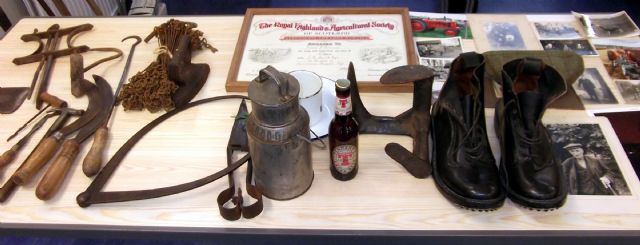
Alec had already set the scene for his talk by putting on display (see above) a most impressive collection of old farming implements and photographs on tables in the hall. Members were able to examine these on arrival.
Alec has spent most of his life in the Cupar area. He was a special constable in Cupar for twenty five years. His family have been engaged in farming for many years. Alec showed us a large Victorian family photograph, showing his grandfather, Old Tam, born in 1872. He had grazed sheep on common land in Tayport. Alec read one of the poems that Tam had composed about his working life in a bothy.
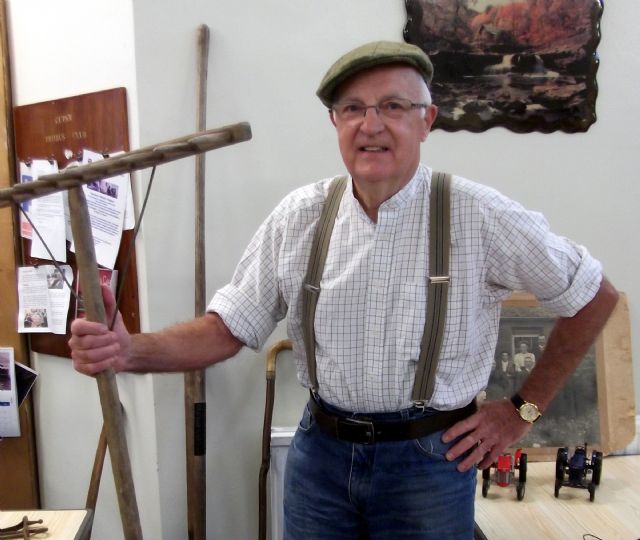
Alex Lorrimer, ready for hire
Pride of place among Alec’s collection that he brought in for us was a bothy kist, which Alec had inherited. He explained that bothies were put up on farms to accommodate teenage workers. Most were wooden structures, but one was a retired double decker bus, which is now on display in a museum. After explaining that the boss of the farm workers was the farm Grieve, Alec read a poem about life in the bothy and on the farm. This was followed by a song called “The Last of the Clydesdales.”
Alec told us that in the mid nineteenth century newly industrialised Britain created great wealth which was invested in large estates and big mansion houses. New farming methods and new crops were introduced to feed the expanding nation. At the end of the nineteenth century mechanisation was replacing teams of scythers, binders, etc. The reaper binder machine in particular made a major impact on farm life. The use of heavy horses for war work in World War One allowed tractors to come into their own. Alec talked about Harry Ferguson, a brilliant engineer, who developed tractors and tractor based systems from the 1930’s. Alec then had us laughing when he told of his own adventures taking his tractor driving test around the crowded streets of Cupar.
Alec illustrated his talk with several ballads - he has a fine singing voice - and he read poetry in local dialect including, “The Ploughman’s Lament” and “Age”, about a farmers thoughts on retirement. He concluded his talk with a bothy ballad about an unemployed farm hand getting a job at Fluthers hiring fair. Club members joined in on the chorus.
Club member, Bob Farmer, then gave a most appreciative vote of thanks on what had been both a hugely informative and very entertaining presentation. This was heartily endorsed by club members.
Report by Colin Moore. Photos by Peter Speirs.
9 May 2018
MY MAGGIES WALKS
Bob Grant
Chairman Colin Moore introduced Dr. Bob Grant as our special guest speaker. Bob was here to talk to us on “My Maggies Walks” and he was superbly qualified for his subject.
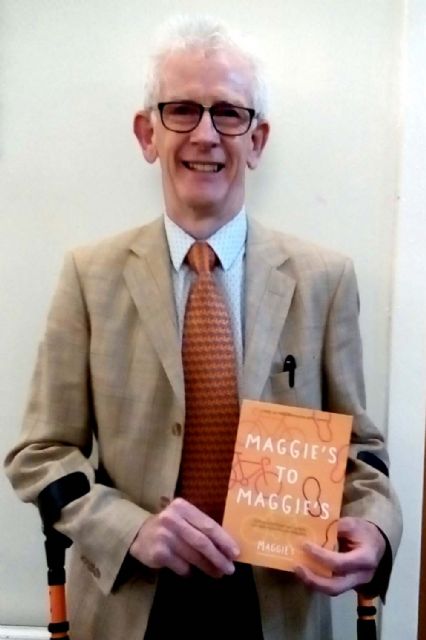
Dr Bob Grant
Bob is a brave and dedicated man, who despite illness enjoyed an active career as a GP in Markinch. After amputation of a leg 15 years ago, Bob, has raised many thousands of pounds for Maggies Centres by walking long distances on his crutches around Scotland. Accompanied by his family and a loyal support group, he has walked around most of Scotland’s famous rambling routes. He told us about the great support that he had from family and friends and also from a variety of business sponsors who supplied professional logistical support throughout. He also highlighted the contribution made by a variety of groups and organisations who had joined him on various sections of his journeys.
His supporters over the years have included a group of 100 Harley Davidson bikers as well as pipers and drummers regularly providing a fanfare as his walks reached their conclusion.
Bob then described the origin of the Maggie’s Centres set up. This was named after an Edinburgh architect who knew that she had benefited from excellent medical care up to her death from breast cancer with friendly and expert support. He said that sufferers often needed a supporting arm around them as well as a needle in their arm.
He then took us on a slide enhanced journey around the eight Maggies Centres in Scotland. The slide show was very professionally managed and arranged by Ken Wilkie, an IT expert, who attended our meeting alongside Bob Grant. These slides took us around the different centres, all individually designed by different architects. All of these centres have a welcoming ambience, where patients feel at home in a welcoming environment. The designs are now famous throughout the world: Bob’s personal all favourite is the one at Dundee with its views over the River Tay.
Bob’s talk was both heart-warming and inspirational. There were several questions and comments from members at the conclusion of the talk and then, Malcolm Gerdes Hansen gave a very warm and appreciative vote of thanks. This resulted in a spontaneous round of applause. There was a collection for “Maggies” at the end of the talk, which raised a grand total of £161.52.
Report by Colin Moore. Photos by Peter Speirs.
11 April 2018
EAST LOMOND HILL FORT
Joe Fitzpatrick
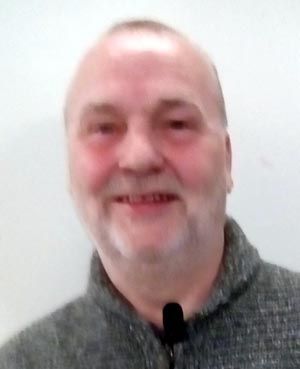
Joe Fitzpatrick
Chairman Colin Moore introduced Joe Fitzpatrick, our speaker for today. Joe is the Director and a Trustee of the Falkland Stewardship Trust which is responsible for the Falkland Estate. He has been actively involved in archaeological fieldwork for a number of years. Joe played a leading part in the 2017 excavation of East Lomond Hill Fort and featured prominently on the BBC’s “Digging for Britain” programme in December 2017. So, he was eminently qualified to talk to us today about “East Lomond Hill Fort.”
He proceeded to do this with great style and verve. He also brought along an excellent screen presentation which perfectly complemented his prose. Our club members were then enthralled for forty five minutes as Joe went through the events and archaeological findings from the 2017 dig on the Lomond Hills. His first slides showed a series of interpretations of how the fort probably looked two thousand years ago.
Joe then explained that the findings from the dig demonstrated that this had been a Pictish fort belonging to an elite local ruling family. There was also firm evidence of a Roman Britain influence during the post invasion period. The dig had revealed some high status glass vessels and semi-precious jewellery ware. Spearheads and other weaponry were also recovered. All the finds had been carefully recorded in situ before being removed for interpretation and future display. The dig also revealed clear evidence of a long straight pathway through the fort which may have had a ceremonial purpose.
Joe explained that the 2017 dig had been an inclusive experience for the people of Fife. Volunteers of all ages had been involved. Bell Baxter School children were shown busily working in some of his slides, as well as several other volunteers from Cupar. Joe was very proud of this community involvement and the feeling of empathy between those living two thousand years ago and today.
After this remarkable presentation, where club members felt that they had been watching an episode from Channel Four’s “Time Team”, there was time for questions and comments from the audience.
Then Ron Campbell’s appreciative vote of thanks resulted in a warm and approving round of applause.
Report by Colin Moore. Photos by Peter Speirs, except the LIDAR.
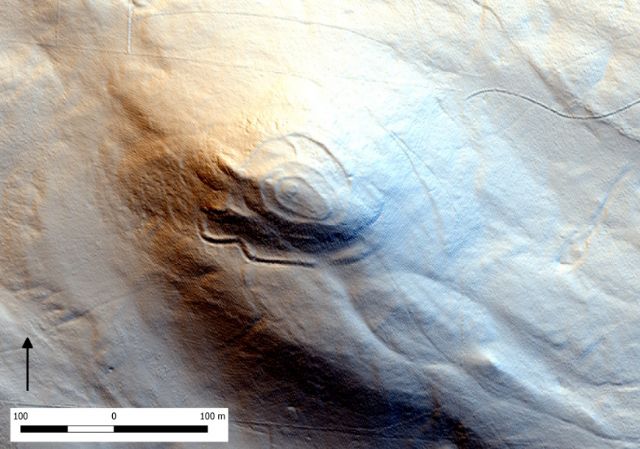
This is a LIDAR (light detection and ranging and imaging) picture of East Lomond.
14 March 2018
LINDORES DISTILLERY
Drew and Helen McKenzie Smith
Chairman Colin Moore introduced our two guest speakers. These were husband and wife team, Drew and Helen McKenzie Smith. They own and manage the Lindores Abbey Distillery.
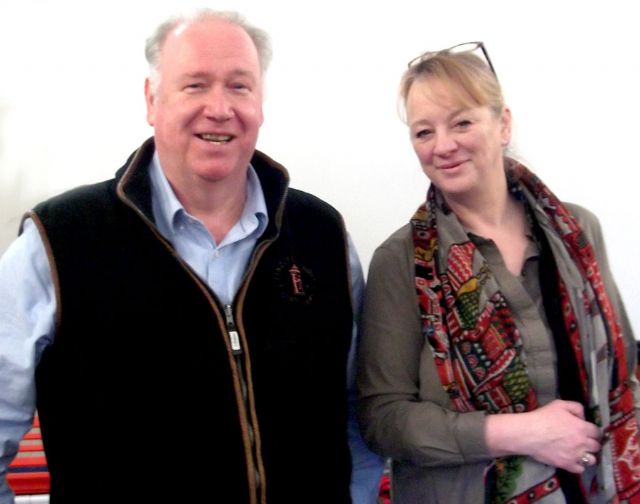
Drew and Helen McKenzie Smith
Drew began his talk with some brief historical background notes. He told us that Lindores Abbey was founded on the banks of the River Tay, near Newburgh, by a French Tironensian order of monks in 1191. The earliest evidence of Scotch whisky being distilled at the abbey is found in an Exchequer Roll for 1494.
Drew explained that four years ago he decided to drive through an ambitious plan to begin distilling again at this historic site. He paid full tribute to Business Gateway Fife for their assistance and expert support throughout the project. They had helped with feasibility studies, early funding and financial forecasts. Drew gave us many insights into the challenges that he had overcome during the project. For example the trade name “Lindores” had been difficult to patent. There was opposition from the chocolate makers Lindt, the producers of “Lindor” chocolates. Drew told us how this problem had eventually been resolved in a civilised manner.
Drew’s talk was complimented by a most impressive slide show, managed by his wife Helen. These superb slides illustrated the massive efforts that have gone into this four million pound project. We saw how original abbey stone has been re-used to build the outstanding new Distillery, Legacy Bar, Apothecary and Visitor’s Centre. Whisky is now being produced in three huge copper stills. There will be no return for ten years, but long term investors have come on board to sustain the project.
After this really interesting presentation, there was time for questions and comments from the audience. Then an appropriate and very amusing vote of thanks was given by Malcolm Gerdes–Hansen, on behalf of all club members.
14 February 2018
FUN WITH WORDS
Michael Mulford
Chairman Colin Moore introduced our speaker, Michael Mulford.
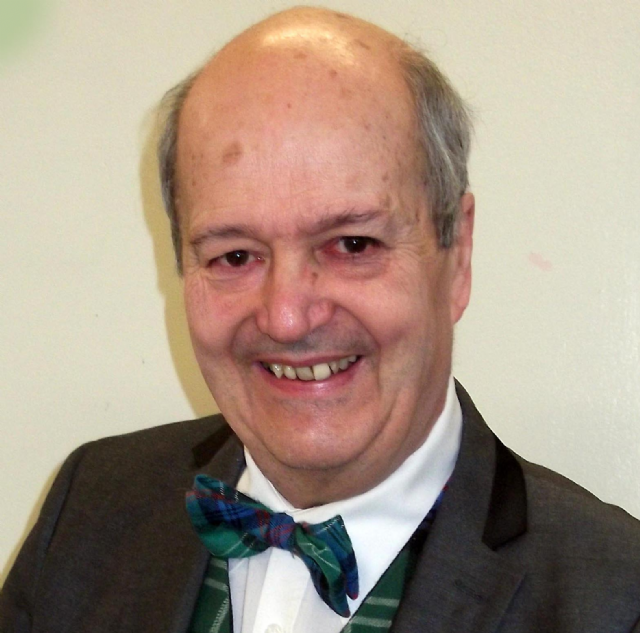
Michael Mulford
Michael has held senior appointments in journalism, television and public relations. He worked at STV as an on screen reporter and presenter and was the first crime reporter at the Dundee Courier. He is a self-confessed “Morphologist” – meaning that he loves big words and phrases.
Michael presented us with a very amusing talk including quotations from a wide range of politicians, celebrities and publications. Michael also took us into word derivations during his presentation. For example, we were informed that the word Trump was first used in 1456 as meaning overbearing, and Trumpery means deceit, fraud and trickery!
He particularly enjoys typographical errors and explained that journalists never let the facts get in the way of a good story!
He gave us many hilarious examples of “typos”, such as in a Dundee Courier obituary, where an army brigadier was described as being “battle scared”. This was hurriedly changed to “bottle scarred” in subsequent editions. Amongst other many amusing anecdotes, he gave us examples of Dundee jute mill dialect and word plays on “Oor Willie.”
He recalled that the BBC infamously and most unfortunately played Bing Crosby’s recording of “Heaven, I’m in Heaven” as a tribute song on the day that he died and that John Kennedy did not mean to say, I am a jam doughnut when he proclaimed, “Ich bin ein Berliner!” Michael continued in this vein, keeping members laughing and groaning with his amusing and entertaining comments.
At the end of his talk, there was time for questions and comments from the audience and then a very well deserved vote of thanks was given by Keith McIntosh on behalf of the members present at the meeting. Club members responded with a hearty round of applause.
Report by John Topliss - photos by Peter Speirs
24 January 2018
RUDYARD KIPLING
Malcolm Gerdes-Hansen
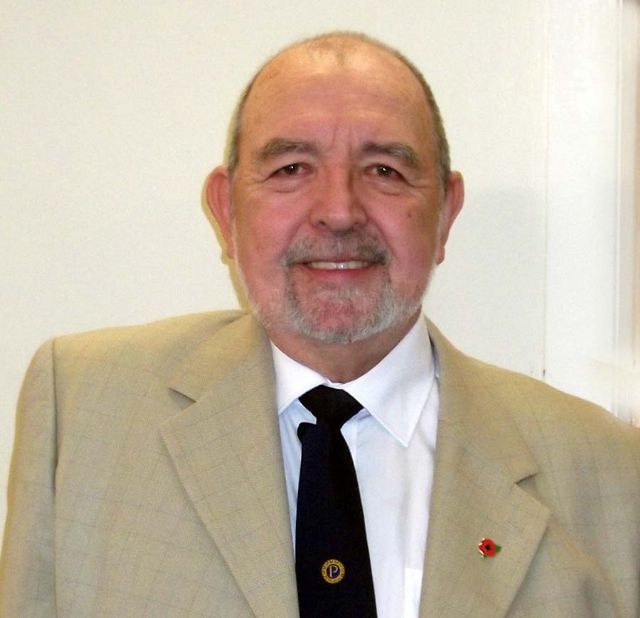
Malcolm Gerdes-Hansen
Chairman Colin then introduced our speaker for today, our own club member, Malcolm Gerdes-Hansen talking about Rudyard Kipling.
Joseph Rudyard Kipling was born to artistic parents in Bombay, in 1865. His father worked there at the School of Art as the Principal of Architectural Sculpture. His unusual Christian name was derived from Rudyard, the Staffordshire village where his parents courted. In 1871, Rudyard and his sister were boarded back in Southsea, England, where they suffered six years of cruelty and bullying. Rudyard called this, “The House of Desolation”. Rudyard found some relief from this hardship in 1878, when he attended the United Services College in Devon. His fellow pupils became the inspiration for his future 1899 classic novel, “Stalky and Co.”
He returned to India where he worked in journalism and began to write short stories. During this period he published his first collections of verse. Malcolm then took us through some of the major achievements of Kipling’s writing career, including the “Jungle Books”, “Captains Courageous”, and the “Barrack Room Ballads” containing “Mandalay” and “Gunga Din”.
During his talk, Malcolm, a declared lover of Kipling’s works, demonstrated the power of his poetry by reading a couple of his poems, including the legendary “Tommy”. Malcolm explained that some of Kipling’s works were criticised for their imperialistic sentiments and racist attitudes. It is interesting to note that Kipling used the left facing swastika (ganasha) on the frontispiece of all his works. This was the Hindu symbol of good luck. But, he immediately removed this from all publications when the Nazis came to power in Germany. He shunned personal publicity and declined offers of Knighthoods, Orders of Merit, and invitations to become Poet Laureate.
He did though accept the Nobel Prize for Literature in 1907. After a remarkable and hectic life, where he mixed with the most influential of people, Kipling died in 1936. This talk stimulated several thought provoking questions and comments from members. After these were aired, Bob Farmer gave a very well deserved vote of thanks on behalf of the members present at the meeting. The members responded with a hearty round of applause.
Report by John Topliss - photo by Peter Speirs
13 December 2017
MINCE PIE DAY
Today we celebrated this special time of year with our traditional Mince Pie Day.
After enjoying our mince pies, coffee and blether, we got down to our entertainment. This was provided by our own club members showing off a wide range of skills.
We enjoyed a really fine mix of music, prose, verse, with plenty of fun and laughter along the way.
All of our performers were thanked for the time and effort that they put into preparing and performing their items.
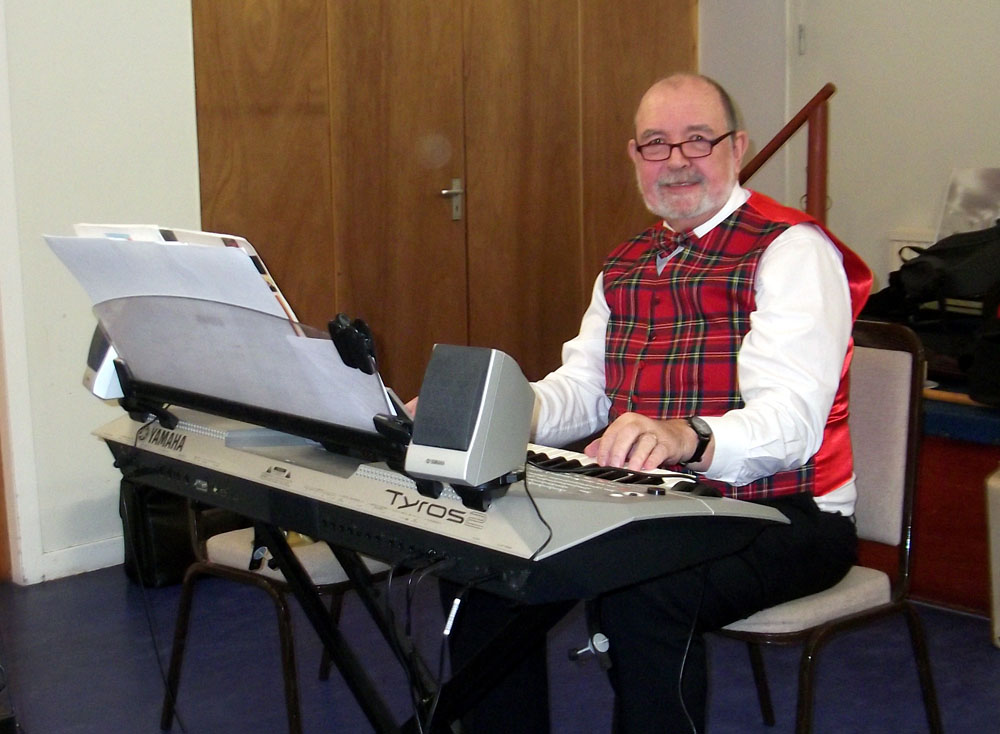
Compere and impressario Malcolm Gerdes-Hansen
A special word of thanks was given to our hard-working impresario in charge of today’s production, Malcolm Gerdes-Hansen.
We really appreciated all his efforts.
Report by Colin Moore - Photo by Peter Speirs
22 November 2017
MY LIFE IN A MESS
Maureen Young
Chairman David Galloway introduced Maureen Young to talk about her Life in a Mess. Maureen is a journalist from Auchterarder who had travelled overseas with the Black Watch and the Royal Scots Dragoon Guards to many interesting locations. She and other journalists were given officer status and stayed in the officers’ mess – hence the title.
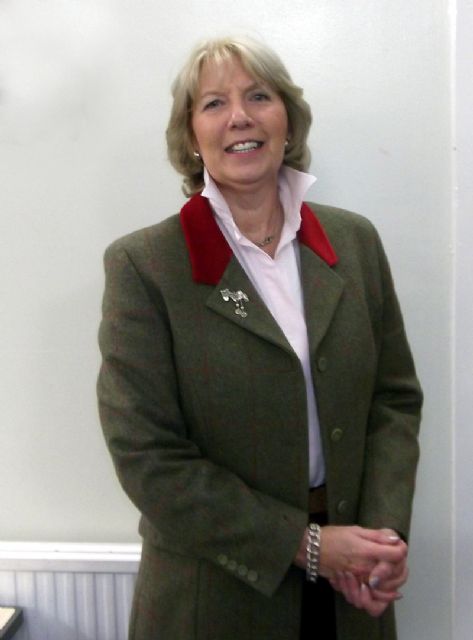
Maureen illustrated her talk with many photos of people and places. In West Germany she enjoyed driving a tank and talked about a horse being trained to be a drum horse which was found to be scared of drums.
Northern Ireland in 1967 was very dangerous but she still managed to sleep through a mortar attack. Everyone moved around by helicopter and she had to jump out while it was hovering a dozen feet above the ground – with a push! Normally Maureen wore army clothing but a photo in Crossmaglen showed her wearing civvies so she didn’t present an obvious target.
Maureen was back in Germany in Berlin in 1989 for the 250th anniversary of the Black Watch, about the time of the fall of the Berlin Wall. The Black Watch was responsible for guarding Rudolf Hess in Spandau Prison, but the regiment was also known for being very smart at formal occasions. It turned out at lots of functions and at one parade President Ronald Reagan was heard to comment on their smartness. About that time the Royal Scots Dragoon Guards gave the Queen Mother a tank as a present – it is not recorded what she did with it.
Maureen visited Hong Kong twice. Apparently the harbour was filthy and toxic and she was warned not to fall in because it could be fatal. The second visit was for the hand back of the territory to China when there were 10,000 media personnel present. The regiment had all their finery on in the torrential rain and then had to get on the planes and leave by midnight while they were still soaking wet.
Maureen visited troops in Kenya where her accommodation was basic. One photo showed her on a “thunderbox”. The Black Watch carried out community projects in the villages. In one the regiment bought a cow for the village. Maureen was encouraged to donate her old trainers in exchange for some soapstone carvings.
Maureen visited Kosovo and recounted some of the horrors she saw and heard there. Subsequently she had a visit to Iraq where she had to don an NBC suit (nuclear, biological, chemical) in raging temperatures of 45 – 50 deg C. The Black Watch was providing support for repair work which included guarding the only bank. She flew about in Chinook helicopters there.
Maureen was lucky to go to the Falklands where the regiment was providing a rapid response force. She found the landscape similar to the Western Isles of Scotland. She also got a good photo of penguins. About that time Maureen was delighted to receive the General Officer’s Commendation for her journalism.
After a few questions, the vote of thanks was given by David Cleland for an interesting and well presented talk.
Report by John Topliss - Photo by Peter Speirs
8 November 2017
CUPALELE
Ed Link
Chairman David Galloway introduced our visitors today, the ukulele band from the Cupar branch of the University of the Third Age, Cupalele, who gave us an hour of splendid entertainment. Their leader is Ed Link and remarkably they play and sing simultaneously without a conductor. They’re in their third year now with members from across Fife. The beginners have been joined by more experienced players who pick out the melody while the others play the rhythm. Their first number, picked no doubt because of that morning’s political headlines, was “The Boys Won’t Leave the Girls Alone” and that Irish folk song was succeeded by songs spanning 90 years from Al Jolson and Bing Crosby to John Denver, the Beatles, the Kinks, Dylan, and the Corries. Probus members joined in heartily in these and numbers like “Edelweiss” or “Singing the Blues” as well. It was explained how the expected F word was not going to feature as George Formby played the banjolele whose bigger size ensured greater volume for a solo vocalist. However the band relented in the penultimate piece where we all leant heartily on a lamp post. For the last item we rocked around the clock though given it was Probus plus U3A there was only singing and no dancing. What a very good reminder how those of us of the third age can fair enjoy it. After a vote of thanks the members gave an enthusiastic round of applause.
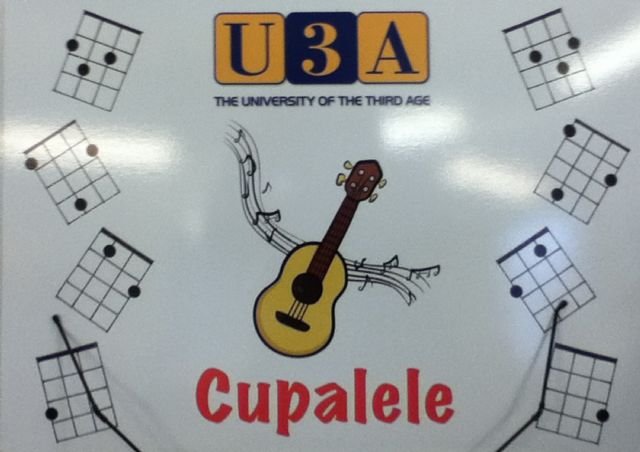
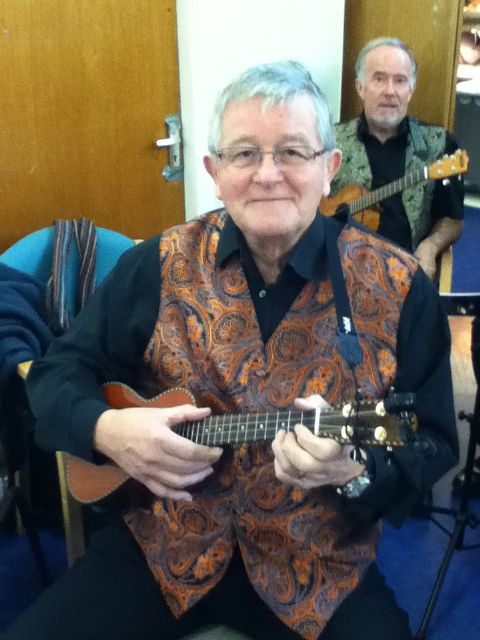
The Leader of the Band, Ed Link
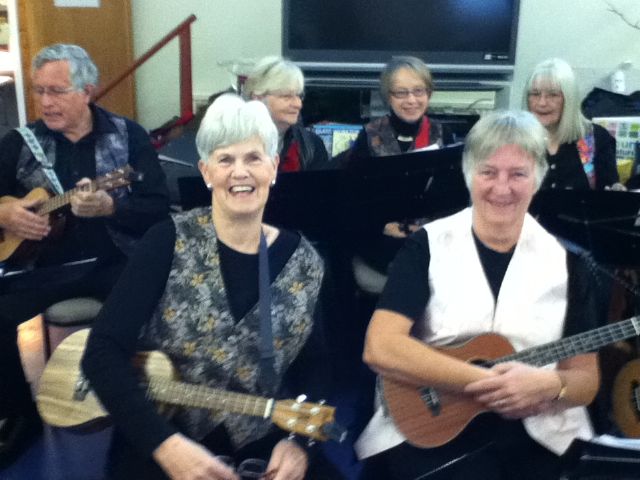
Just a few of the band
Report by David Cleland - Photos by Colin Moore
25 October 2017
FIFE SIGNPOSTS
Paula Martin
Chairman David Galloway introduced our guest speaker for today, the local Cupar historian Paula Martin. After retiring from her academic career, Paula is now Cupar based and is the editor for various historical publications.
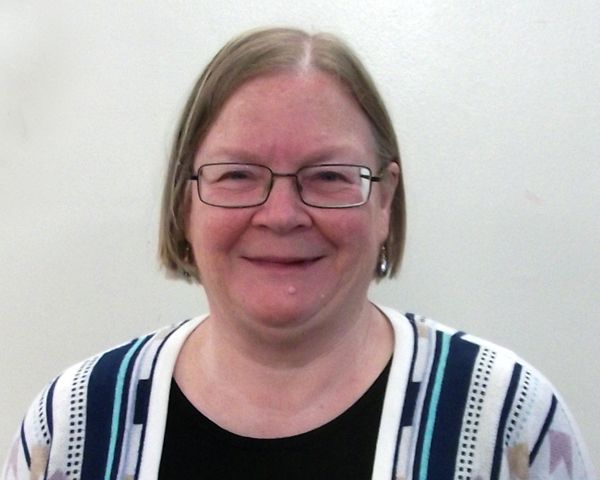
She has been involved with the research into Fife Milestones since 2004. She has found it to be a fascinating subject. She explained that milestones have been around since Roman times and appear in traditional tales such as Dick Whittington and through to the novels of Charles Dickens.
Fife milestones are usually cast iron. They are traditionally painted white with black lettering designed to stand out to travellers. Some can now be quite difficult to spot because of subsidence and verge changes. A lot are very attractively lettered in old script. They can now be seen only in Fife and not anywhere else in Scotland. All milestones and signposts were immediately removed throughout the U.K. at the start of the Second World War. A lot were destroyed and the cast iron was used in the armaments business at that time. The Fife roads Inspector took a different course of action at the start of the war. He providentially stored away the Fife milestones and then carefully restored them to their correct positions in the post war years. Fife was the only county to do this at that time. We are indebted to him today for his foresight giving us this magnificent ongoing link to our past. It is now recognised that these milestones are an attractive and important part of Fife’s heritage. The council now carefully maintains them and replaces them in cast iron where necessary. They go back to the eighteenth century where wheeled transport became more common due to the introduction of turnpike roads. This brought a need for travellers to know directions and distances.
Paula’s talk was supported by an impressive set of photograph slides detailing the variety found in the different milestones on view around the county today. This was part of an excellent PowerPoint presentation. These photographs are all from her own personal collection gathered together over the last fifteen years. Her fascinating and thought provoking talk produced lots of questions from the members present. After question time, Roddy McLeod gave a most amusing and gracious vote of thanks.
Report by Colin Moore - Photo by Peter Speirs
11 October 2017
CLASSIC CRIME FICTION
Colin Moore
Chairman David Galloway introduced our speaker for today, our own club member, Colin Moore. His subject was “Classic Crime Fiction”.
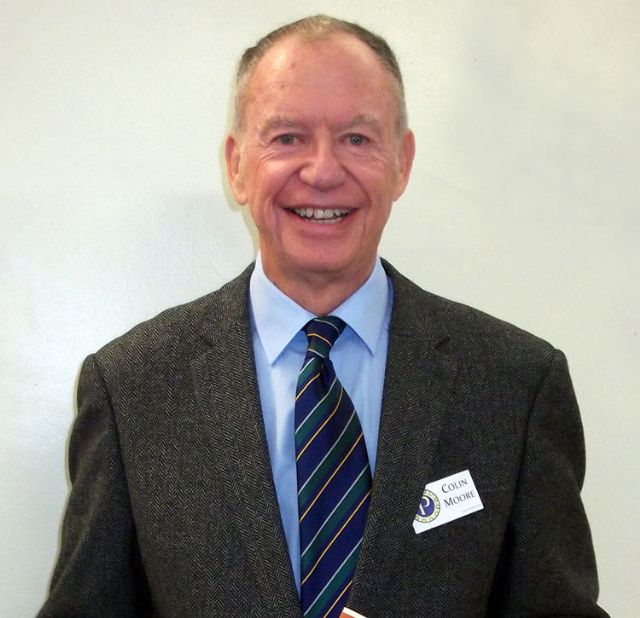
Colin explained to us how he first started collecting Crime Fiction when he was twelve years old. His first book was an old and tattered second hand copy of “The Mysterious Affair at Styles”.
Over the years, he has built up an extensive crime fiction library in his own home. He developed his theme by defining the meaning of crime fiction and then told us about some of his favourite authors. He read short extracts from some of these classic crime novels during his talk. His presentation was complimented by a slide presentation of relevant book covers, photographed from his own collection.
Colin then told us about the Queen of Crime Fiction, Agatha Christie. He introduced her detectives and talked about some of her books and plays. Thanks to television, Agatha Christie remains a top selling author to this day. He then brought things up to date by talking about modern authors writing in the style of the Golden Age of Crime Fiction. These included Rebecca Tope and James Runcie.
Colin’s talk generated a lot of very interesting questions from club members. After question time, Bert Oliver gave a suitably entertaining and very well deserved vote of thanks.
Report by Colin Moore - Photo by Peter Speirs
27 September 2017
FIFE FLYING CLUB
Alan Laing
Chairman David Galloway welcomed our guest speaker for today, Alan Laing of Fife Flying Club accompanied by Chris Anderson, chairman of the Club.
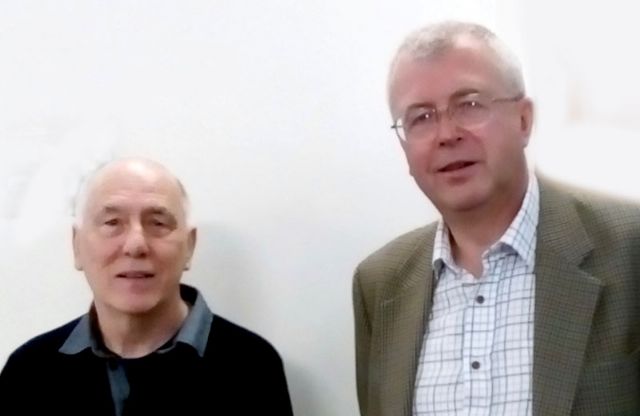
Chris Anderson and Alan Laing
As part of a syndicate Ian owns and flies a Socata TB9 Tampico, a beautiful small private ‘plane based at Fife Airport outside Glenrothes, shown below.

The TB9
He told us of the various activities and open days at the airport and of its contributions to various good causes; he recommended the Tipsy Nipper restaurant. Sometimes he is involved in flying out piggyback parachutists raising money for charity though he himself has only jumped once. Various technical details to do with power and weight explained why he picked the TB9 and he went into the financial costs involved for the syndicate. He explained too that although pilots fly now by GPS they are still legally obliged to have a chart on board as well. He reminisced of the pleasure of flying to islands like Coll or Tiree for the afternoon.
However Ian is not just a pilot but a skilled photographer and the second part of his talk gave evidence of this in a succession of beautiful photographs taken from the sky. We saw the Queensferry Crossing at various stages of construction>
With permission pilots may fly over the centre of Edinburgh, so that we viewed the Castle or Princes Street from above. There were shots of Ben Nevis or Glencoe in bad weather as Ian explained that if you never ever flew in bad weather you’d rarely take off in Scotland.
However there were many shots in fine weather too; those over the sea could reveal its shapes and wave patterns in the varying light. One notable example of the detail provided was the sight of the Sugar Boat wreck opposite Helensburgh at the Tail of the Bank in the Clyde. The Club offers flights down the coast from the airport to Crail and back and it was especially interesting to view scenery we all knew so well a different angle.
It is good for us to be reminded that our lines are fallen in such pleasant places and Ian’s doing of this was much appreciated.
After a few questions a vote of thanks was given by Alex Ness and the members responded in the usual manner.
Report by David Cleland - Photos by Peter Speirs and Alan Laing
27 September 2017
FIFE FLYING CLUB
Alan Laing
Chairman David Galloway welcomed our guest speaker for today, Alan Laing of Fife Flying Club accompanied by Chris Anderson, chairman of the Club.

Chris Anderson and Alan Laing
As part of a syndicate Ian owns and flies a Socata TB9 Tampico, a beautiful small private ‘plane based at Fife Airport outside Glenrothes, shown below.

The TB9
He told us of the various activities and open days at the airport and of its contributions to various good causes; he recommended the Tipsy Nipper restaurant. Sometimes he is involved in flying out piggyback parachutists raising money for charity though he himself has only jumped once. Various technical details to do with power and weight explained why he picked the TB9 and he went into the financial costs involved for the syndicate. He explained too that although pilots fly now by GPS they are still legally obliged to have a chart on board as well. He reminisced of the pleasure of flying to islands like Coll or Tiree for the afternoon.
However Ian is not just a pilot but a skilled photographer and the second part of his talk gave evidence of this in a succession of beautiful photographs taken from the sky. We saw the Queensferry Crossing at various stages of construction>
With permission pilots may fly over the centre of Edinburgh, so that we viewed the Castle or Princes Street from above. There were shots of Ben Nevis or Glencoe in bad weather as Ian explained that if you never ever flew in bad weather you’d rarely take off in Scotland.
However there were many shots in fine weather too; those over the sea could reveal its shapes and wave patterns in the varying light. One notable example of the detail provided was the sight of the Sugar Boat wreck opposite Helensburgh at the Tail of the Bank in the Clyde. The Club offers flights down the coast from the airport to Crail and back and it was especially interesting to view scenery we all knew so well a different angle.
It is good for us to be reminded that our lines are fallen in such pleasant places and Ian’s doing of this was much appreciated.
After a few questions a vote of thanks was given by Alex Ness and the members responded in the usual manner.
Report by David Cleland - Photos by Peter Speirs and Alan Laing
13 September 2017
THE SOUNDS AND VOICES OF WORLD WAR 2
John Carder
Chairman David Galloway, welcomed today's speaker, John Carder, from Cellardyke to give a talk about “The Sounds and Voices of World War 2”.
Before starting the talk John handed out supporting handouts including the front sheet of the Daily Mail of 17 October 1939 and several photos.
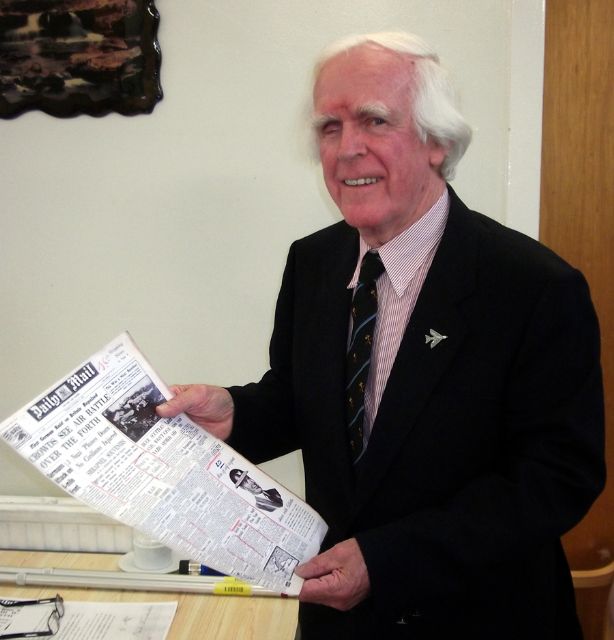
John Carder
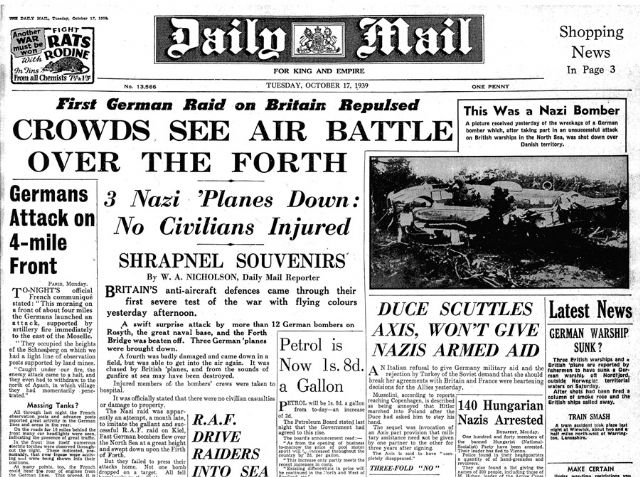
John, who was born in London, explained that he became a serving officer with the RAF, but he was a schoolboy in London during World War 2. He remembered the exciting time of being in Piccadilly Circus on VE Day outside the Rainbow Club (the US equivalent of the NAAFI) when a jazz band was playing. The wireless (radio) was the main means of communication at that time, and his family’s one was powered by an accumulator.
Bob then played some key recordings from the BBC to illustrate the progress of the war as told by politicians and presenters. It started with the Chamberlain speech in 1938 about “peace in our time”. He was seen as weak, but he had been advised that we couldn’t win at that time. A Hitler speech followed. Several well-known and less well-known speeches by Churchill were played, followed by a rousing speech by Roosevelt after the bombing of Pearl Harbor by the Japanese.
John also played unusual sounds of a Lancaster bomber aircrew radio flying over Berlin during a raid, a V1 Flying Bomb, and a V2 rocket exploding. We were brought back to earth with the classic recording by Richard Dimbleby of the horrendous conditions he found at the Belsen concentration camp. This recording was blocked by the BBC at the time as being too frightening.
John ended the talk with Vera Lynn singing “We’ll Meet Again”. Unfortunately, there was no time available for questions so Peter Speirs gave a suitable vote of thanks to John for his fascinating and unusual talk.
Report by John Topliss - Photo by Peter Speirs
26 July 2017
SWEET PEAS
Chairman David Gallaway welcomed Tom Nelson to give a talk about Sweet Peas. Tom, who is from Cuparmuir, had already set the scene by putting out displays of sweet peas in the hall before the talk.
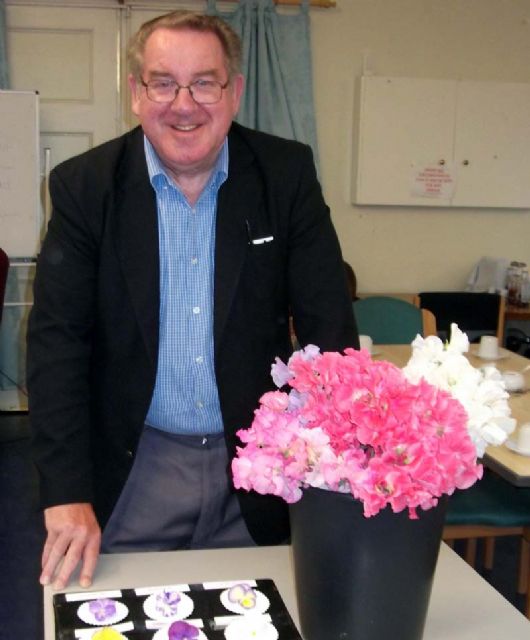
Tom Nelson
Tom has had a horticultural background for 40 years and became hooked on sweet peas after winning his first trophy at the Kingsbarns show. Apparently Cupar is famous for sweet pea growers. The first sweet peas came to Britain in 1699 from Sicily, and a variety “Painted Lady” from about that time is still available. Growing sweet peas is not expensive, and several sweet pea catalogues are available showing as many as 1300 varieties. Seed prices vary considerably but can start as low as 99p for 300 seeds according to variety – bigger flowers are more expensive. Showing sweet pea has been popular for a long time. At a show in 1912 there were 35,000 entries and a top prize of £1000. There are still many shows in Scotland although the number is falling. Tom grows about 400 sweet peas, and as well as showing them, is also a judge. He considers sweet peas value for money because of the long flowering period, although they only last a few days when cut.
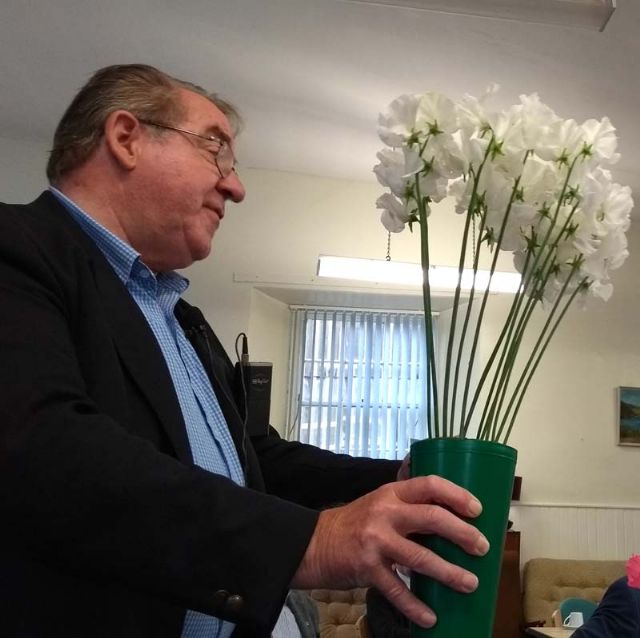
Tom talked, among other things, about how to germinate seeds, get long stems, and to cut flowers hard to encourage more flowers. The best perfumed flowers are white, cream and blue. He ended his talk with a demonstration of how to create a display suitable for a show. Tom is a relaxed speaker whose informative talk was supported by many amusing stories and experiences which kept the audience well-entertained. After some lively questions, member John Dewar, a well-known horticulturist, gave a suitable vote of thanks.
Report by John Topliss - Photos by Peter Speirs and John Topliss
12 July 2017
HEALTH AND HAPPINESS
Our speaker today was Dr. Roger Stark and his subject was "The Happiness Business."
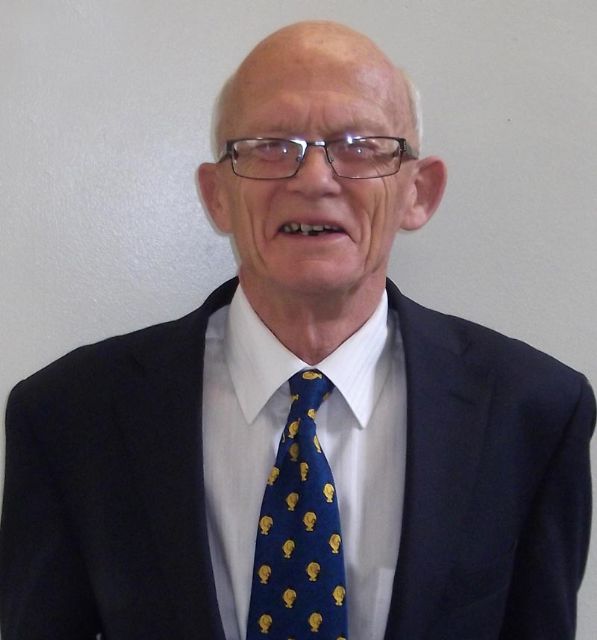
Roger Stark and his Mr Happy tie
Roger talked us through the science of happiness. He explained about our body chemistry and took us through the happy chemicals, such as endorphins, oxytocin and serotonin which are present in our brains and surge though our bodies when required. These can be triggered at different times according to our individual situations and needs. He explained that hormones in the body govern what we do and what we think.
Roger took us through the United Nations Happiness League where the happiest country is Denmark. The Danish score highly with measures such as fairness, stability, security, opportunity and freedom. He then took us through ways that we can top up our own happiness. These included fresh air, sunshine, achievement, excitement, exercise, friends, music and laughter.
Roger's presentation included a wide range of really amusing slides combined with suitably enhancing musical sound tracks. He talked with great humour and engaged the whole audience in continuous laughter.
Douglas Provan gave a well deserved vote of thanks, praising Roger's very interesting and amusing presentation. Douglas quoted Harry Lauder, as saying, "Happiness is one of the few things in the world that doubles every time you share it with someone else."
One thing is for sure, after such an entertaining talk, Roger certainly left Cupar Probus Club members in a very happy state.
Report by Colin Moore - Photo by Peter Speirs
28 June 2017
SCOTTISH POETRY
Today's speaker, club member, Roddy MacLeod, treated us to a collection of some of his favourite Scottish Poetry.
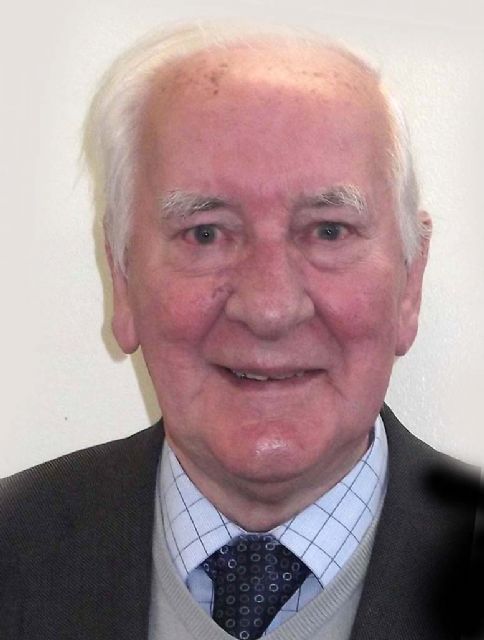
Roddy MacLeod
His collection ranged from the early poem, "The Lament of the Makkers" by William Dunbar written in 1460, through to modern day offerings from the likes of W. N. Herbert with "The Ballad of Techno Fear". Some of these poems included dialectic words and phrases that have now been lost in time. But, when performed by a master teller, like Roddy, they still retained all of their rhythm, humour and harmony.
He included a selection devoted to William McGonagall, famous for managing to make everything rhyme, however distorted and contrived. Roddy explained that in a world where some clever people try to be silly, McGonagall was a silly person trying to be clever!
Roddy engaged wonderfully well with his audience throughout his presentation. He performed his programme with great joy and an infectious delight, which was shared by all present in the hall.
Like all skilled performers, he left the audience asking for more. After an interesting question time, John Topliss, gave a well deserved vote of thanks, praising Roddy's delivery and presentation of a fascinating programme of poetry.
Report by Colin Moore - Photo by Peter Speirs
14 June 2017
DRY CLEANING SECRETS
Chairman David Galloway, welcomed Robert (Bob) Hutchison, a member of Glenrothes Probus Club, to give a talk about “The Dark Secrets of Dry Cleaning”.
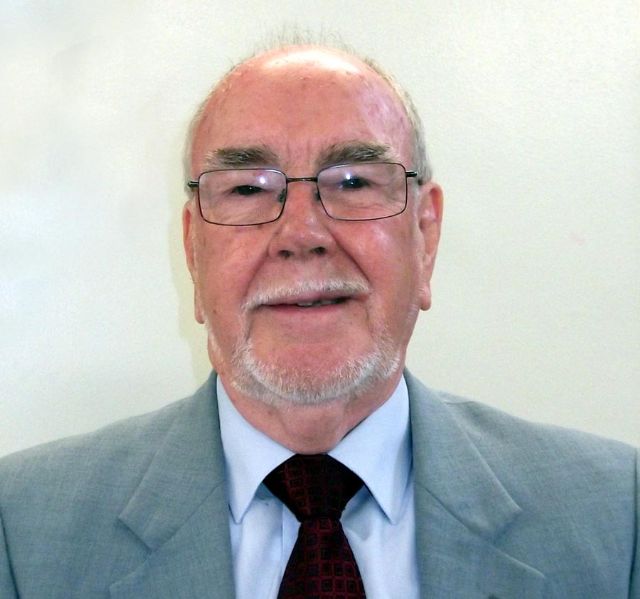
Bob Hutchison
Bob, who had worked in the dry cleaning industry, led us through the history and development of dry cleaning apparently starting with Jean Baptiste Jolly in Paris in the 1840s accidently spilling spirit of turpentine on a table cloth and noticing that it cleaned the cloth. This soon developed into a full scale activity called “nettoyage a sec” i.e. dry cleaning.
By 1857 dry cleaning factories had been set up in Paris and elsewhere with clothing supplied from collection centres. These new factories tried various different solvents to improve the cleaning performance. These included petrol, paraffin and benzene, and chlorinated salts, which were safer. Carbon tetrachloride was very effective and used widely for some time but was eventually banned because of its toxicity.
In between the wars perchloroethylene, or PERC, started to be used which was much safer. Although other solvents have been tried, including liquid carbon dioxide, PERC is still the main solvent used for dry cleaning today. Machines were used at an early stage in the development of dry cleaning and over time they were developed to give better cleaning using a 3-stage process. The first stage is washing, where soap could be added, the second stage is rinsing, and drying is carried out in the third stage. Originally much of the solvent was lost in the process, but because of costs and ever tightening regulations, dry cleaning machines were developed to totally recycle the solvents.
Bob completed his talk by saying that, unfortunately, because much of modern material can be cleaned at home in the washing machine, the dry cleaning industry is slowly disappearing. However there will always be a need while men continue to wear suits which cannot go in the washing machine. After some interesting question from members, Keith McIntosh gave a deserved vote of thanks.
Report by John Topliss - Photo by Peter Speirs
24 May 2017
OPERA IN SCOTLAND
One of our own members Iain Fraser gave a fascinating talk on Opera in Scotland.
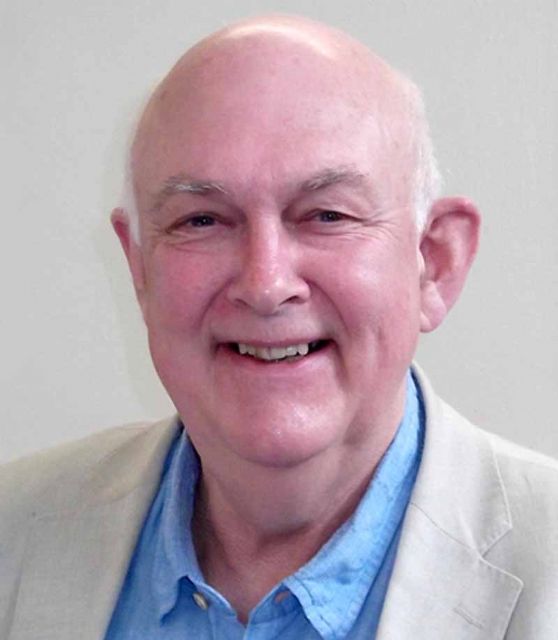
Iain Fraser
He and his brothers have set up the website http://www.operascotland.org which lists 680 operas, 11,000 artistes, and 22,000 performances.
This was started in 2008 in response to Scottish Opera’s giving no performances for a year amid claims that opera was “never part of Scottish culture”, despite the Edinburgh International Festival and the fact that nowadays Scottish Opera is seen by 80,000 people a year and is the largest performing arts organization in Scotland.
Iain mentioned two operas that were performed in Scotland in the 1720s: one of them, The Beggar’s Opera, still being known today. That century it was one of the first to be criticised for lewdness and immorality as happened also next century to La Traviata. As railways eased communication operas came to Aberdeen, Dundee, and Glasgow. By the 1850s Glasgow, with 20,000 pianos in the city, indeed claimed to be just as appreciative of culture as Dublin.
Iain’s talk then divided in two: opera stars who visited Scotland, like Gigli or Jenny Lind together with decades of tours from Carl Rosa’s company and those who hailed from here like Mary Garden, or Joseph Hislop who died in Lundin Links. Dame Nellie Melba who studied music in Melbourne (hence her stage name) was born to immigrant parents called Mitchell who came from Forfar and Tayport.
Our speaker ended with Alexander Gibson’s founding of Scottish Opera in 1962 and then as a superb encore let us imagine we were sitting in the stalls in the Lyceum in 1889 as we listened to a 1903 recording of Zélie de Lussan as she sang an aria from Carmen. Bravo!
A few comments and questions from the members followed before Mike Edwards proposed the vote of thanks.
10 May 2017
NASA SPACE CENTRE
Our speaker was John Beaton MBE. He talked to us about the NASA Space Centre. It soon became clear that John was particularly well qualified to talk about this subject. He is a regular visitor to NASA. In 2007, John created, in partnership with NASA, the Discovery STEM Space School. To date, this has enabled 44 local Fife primary school children to visit Houston and consider sciences as a future career. Astronauts and Cosmonauts visit and teach at Abertay University as part of the programme. John is now an official International Friend of NASA.
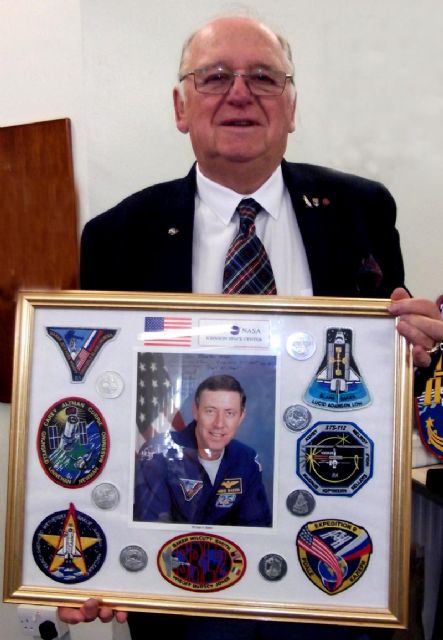
With the aid of a slide presentation, John took us on a reality tour of the NASA Space Craft Hall. We then looked at the Discovery space shuttle. We "visited" the lower front deck and then proceeded up to the upper cockpit. We viewed a mission from the Mission Leaders' seat. The flight deck was very complicated. In front of the mission leader is a control panel with thousands of switches. Strangely, he explained that the most vital aid on a space shuttle was Velcro. Everything is attached with Velcro because of zero gravity. We even visited the toilet during our virtual tour! It was very interesting to learn about how using the "loo" is a real issue for astronauts!
John then compared the USA shuttle with the Russian Soyuz space craft. He then went on to the International Space Station which orbits the planet Earth every ninety minutes. The Apollo Mission Control Centre is now open as a space museum complete with working models of craft and simulations of space craft and control desks.
This was a fascinating talk given by a man with first hand experience. Ron Campbell gave an amusing and appreciative vote of thanks. The members present showed their appreciation with a fine round of applause at the end of the talk.
26 April 2017
SCHOOLDAYS
Chairman David Galloway welcomed Hedydd Anderson, who introduced herself by explaining she is Welsh and her name means Skylark. Apparently her ornithological father decided it was a good name as she was born early in the morning.
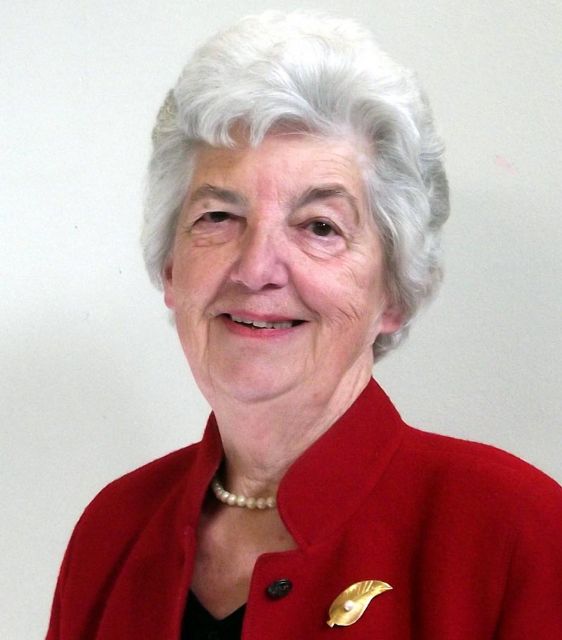
Hedydd explained that she had a career in teaching. After qualifying in French her first post was at a girls’ school in Shrewsbury. She was there for four years and recounted how in 1963 the River Severn froze and cars could drive across it. Subsequently she married a Scottish engineer and moved to Edinburgh.
There she worked for five years at a boys’ school where she was the only female teacher. This gave her plenty of spare time because only the male teachers would do some activities such as games and the school CCF. Hedydd particularly remembered Mondays when the cadets’ boots clattered on the stairs.
Hedydd explained that she was very keen on good French pronunciation, and gave an amusing demonstration in French on how she coached a boy for an oral exam. When the examiner tried to trip a boy up by asking the French for “leek”, the examiner was impressed when the boy replied with the right word “poireau”. The reason for this was clear – Hedydd is Welsh and the leek is the symbol of Wales.
In 1972 Hedydd and her husband moved as a couple to teach French and science respectively in St Mary’s school in Melrose, where they were also responsible for boarders aged 8 to 13. At the holiday breaks the boys all had to be packed off home, some by air to overseas destinations
Hedydd told of the happy times – playing board games in front of the fire, singing with the piano. But there were the sad times – watching QE2 going to the Falklands with the fathers of two boys on it was one.
Working at St Mary’s was an uplifting and broadening experience for Hedydd and she illustrated her talk with many interesting and amusing details about her 25 years at the school. She finally became Deputy Head when she moved from being a teacher to an enabler. Hedydd is a very good speaker and her audience was hanging on every word.
After a few questions, a well-deserved vote of thanks was given by Robert McCririck.
Meeting report by John Topliss - photo by Peter Speirs
12 April 2017
ERIC LIDDELL
Chairman David Galloway introduced our speaker for today, Sue Caton.
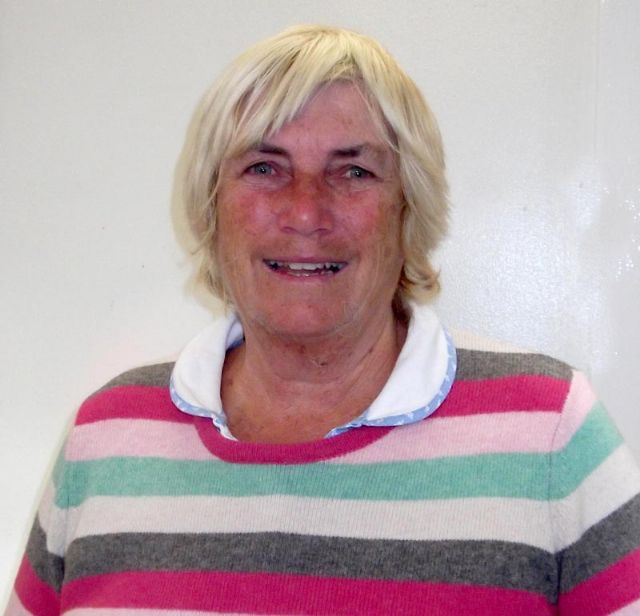
Sue is Eric Liddell’s niece and patron of the Eric Liddell Centre, Edinburgh. She never knew her uncle who died in a Japanese internment camp in China during the war but has an extensive knowledge of the famous athlete and missionary and of his family which she shared with Probus members in a fascinating blend of pictures, and extracts from recorded reminiscences.
The Liddells can be traced back in the Drymen area to the 1750s. Eric’s father was a Congregationalist missionary who worked in China from 1898, just before the Boxer Rising. He married in Shanghai Cathedral and Eric was born in 1902. Educated at boarding school in England, he went on to study science at Edinburgh University. From 1920 to 1924 he won almost every race he ran in together with playing rugby for Scotland seven times.
Most famously at the 1924 Olympics he refused to run heats on a Sunday for his favoured distance the 100 metres, instead settling for the weekday 400 metres where he won gold. At his Edinburgh graduation he was crowned with laurel leaves and carried out on the shoulders of his fellow graduates and when he left for the China he was taken to Waverley on a decorated horse drawn carriage.
Apart from trips home he spent the rest of his life in China both in Peking and in the more dangerous Inner Mongolia, teaching science and evangelizing. He married a Canadian nurse and had two daughters: we heard on recordings of mother and daughters with some of their reminiscences. They left for safety in Canada and then Britain in 1941 but Eric felt it his duty to stay on with his converts and pupils. Interned in 1943 he died of a brain tumour in 1945, never seeing the third daughter whom his pregnant wife was carrying when she left.
When he saw the situation of the young internees he overcame his sabbatarian principles and helped them with sport on Sundays. He always remained famous in Scotland and his reputation increased with the slightly inaccurate Chariots of Fire film in 1981.
Statues and memorials have been erected in both Edinburgh and China but Sue explained how his best memorial was his Centre at Holy Corner and its work with dementia sufferers and their carers.
Past Chairman Bert Oliver proposed the vote of thanks with the members giving a hearty round of applause.
Meeting report by David Cleland- photo by Peter Speirs
22 March 2017
THE VICTORIAN ASYLUM
Chairman David Galloway introduced today’s speaker Guthrie Hutton, author, and chairman of Cupar Heritage Centre to give his talk on Victorian asylums.
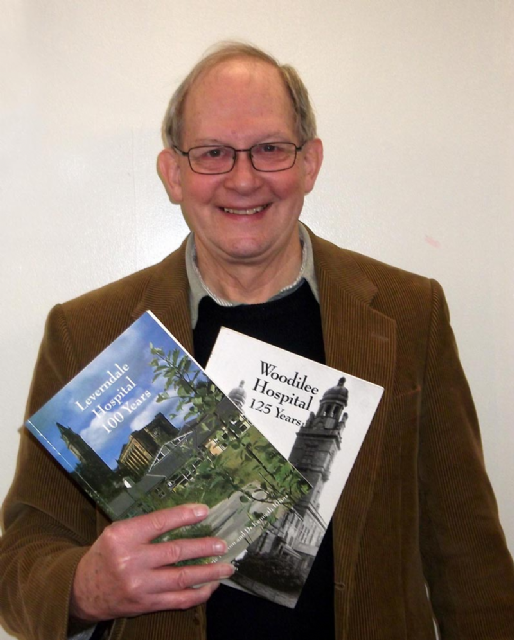
Guthrie Hutton’s interest in Victorian asylums, first awakened when he was commissioned to write histories of such institutions about to be closed down in Glasgow in the ’90s, was revived when organizing Cupar Heritage Centre’s exhibition for Stratheden’s 150th anniversary. We much enjoyed sharing the fruits of this further research with an historical account followed by relevant photographs. Before the late 1700s the mentally ill were locked up in the town tolbooths and could often be viewed as a source of amusement but then charitable institutions began to be founded: they can often be identified by having "Royal' in their names. By 1848 parochial boards had to set up and supervise poorhouses with separate basic provision for “pauper lunatics” but from 1857 county boards were established. Their asylums had to be within two miles of a railway and be 30-70 acres in size. No medications were available but it was rightly felt that work on the land could be therapeutic. Fife and Kinross Lunacy Board acquired the Springfield site in 1864 and the asylum, only renamed Stratheden with the coming of the NHS in 1948, was set up, bringing great financial benefits to Cupar tradesmen. As in other such institutions the inmates enjoyed sports like football and cricket while local groups came in to provide entertainment. After briefly going through more recent developments such as the end of this kind of asylum system, signalled in the 1960s by Enoch Powell when Minister of Health, Guthrie then gave a slide show of the sites and the people from all over Scotland. The former showed the majestic buildings with water tanks in their high towers, set in huge estates whose splendid gardens were well tended by the patients. The latter slides showed the staff and wards and workshops as well as dances and sports days. Although we went in thinking this would be a gloomy subject we came out realizing that for all the faults due to imperfect medical knowledge the setting up of asylums was a worthy example of Victorian enlightenment in which they invested money, involvement, and pride. A question and answer session followed before Colin Moore gave the vote of thanks.
Meeting report by David Cleland - photo by Peter Speirs
8 March 2017
LIFE AS A TOASTMASTER
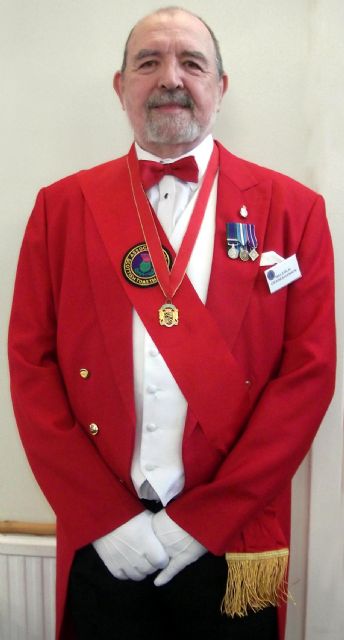
Probus was brought to order by one of its members, dressed in scarlet, shouting stentoriously and banging his gavel three times. Malcolm Gerdes-Hansen from Shetland Isles and in his long life holder of more GB caps in water polo (93 as goalie) than anyone else, is now one of Scotland’s fourteen duly qualified professional toastmasters and gave a fascinating talk both on the history of toast and his life as toastmaster.
He explained how in the thirteenth century the wine was so dreadful that it needed to be improved with heated bread and spices which were left at the bottom of the cup and eaten thereafter: hence our idea of a toast, a word first used for honouring with drink in Bath in 1649 with drunken frolics in the ladies’ spa.
By 1847 toastmasters were the ones to call for silence and by the end of century started wearing scarlet frock coats thanks to Edward VII while Prince of Wales. Nowadays they have to learn protocol, procedure, and etiquette. They should never talk of “bride and groom” as grooms only tend horses but of course “bride and bridegroom”.
Never say “Be upstanding for ….” Because when that’s said in court it really does mean “upright, honourable”: it’s the usher who says “All rise!” In his time Malcolm, trained by the Queen’s toastmaster, has had to learn how to address a Greek bishop (“Your Beatitude”).
Something only he in Scotland has learned is sabrage. In Napoleonic times French hussars returning to barracks would attempt to open a bottle of champagne with their sabres; the winner would then share his wine with camp followers.
Malcolm had his sabre with him and expertly and speedily demonstrated how to do this. The bottle was opened undamaged and donated to the ladies of the Age Concern staff.
A splendidly entertaining morning especially for those of us who have never been invited to banquets and weddings of that calibre.
A lively question and answer session followed before a vote of thanks was given by John Topliss.
22 February 2017
A BAIRN AT LARGE
Chairman David Galloway introduced Cupar Probus member, Robin Thomson, who gave a talk entitled “A Bairn at Large”.
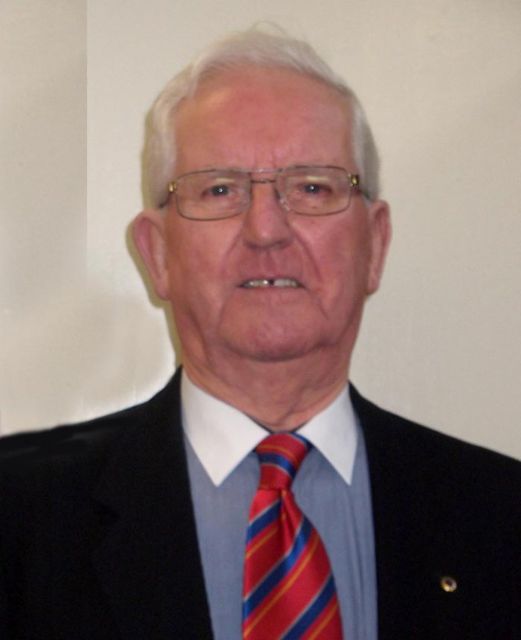
After a witty introduction, Robin talked of his experiences when he lived in the village of Husthwaite in Yorkshire. In the Norman church some of the gravestones had as few words as possible to keep the engraving cost down, and some also had unintended humorous mistakes.
Apparently the performer, Stanley Holloway was in the Yorkshire Regiment in World War I and was quick to use the local accent. Robin then demonstrated the accent with a wonderful presentation of “Albert and the Lion” which Stanley Holloway had first presented in a local Working Men’s Club.
Robin then changed accent to demonstrate some witticisms and curious rhymes from the American poet and broadcaster, Frederic Ogden Nash.
Back to the North of England, Robin was moving into a new house in a new road in Guisborough called Buce Loo Close. Some investigation revealed a Scottish connection, and the road is now called Buccleuch Close!
Robin talked about a variety of subjects, including Hartlepool, Burns’ “Address to a Haggis”, quotes from Ronald Reagan, and the work of Scottish writer and poet, John Buchan. Buchan wrote 27 novels, including the well-known “39 Steps” but is also known for his poetry. Robin finished with a beautiful delivery of two of Buchan’s poems.
After some appreciating comments from members, a well-deserved vote of thanks was given by Angus Allan.
Meeting report by John Topliss - photo by Peter Speirs
10 February 2017
HILL OF TARVIT
Our speaker today was Dakers Fleming talking on Hill of Tarvit Mansion House. Dakers is Chairman of the East Fife National Trust Members Centre and has been a guide at the Hill of Tarvit for three years.
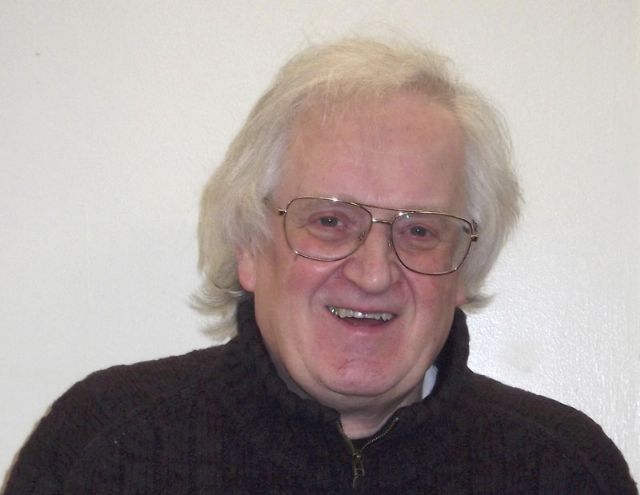
Dakers gave us a tremendous talk combining visual images together with a well informed commentary on the history of the house and its present role within the National Trust.
He began by putting the house into a geographical perspective and the took us back to its beginnings with the tragic story of its owners, the Sharp family. He told us about Hugh Sharp. He was a great sports enthusiast, but sadly died when two trains collided near Glasgow in 1937.
In the second part of his talk, Dakers, gave us a virtual tour of the house and grounds. The house was built for entertainment and house parties. We were taken into every room of the house via slide images. It was built as a very comfortable family house. This can still be appreciated today. The drawing room has a fine collection of French furniture. The dining room is particularly well regarded and is a highlight of any visit.
Sport was at the top of the list for house guests, with tennis, billiards, curling, shooting and croquet all in evidence. There was also a hickory golf course set up for guests. Some of these sports are today still available for National Trust visitors to enjoy. The hickory golf course is still in action, with the house providing visitors with sets of golf clubs.
This was a first class presentation from Dakers Fleming. He deserved the appreciative vote of thanks given by Malcolm Gerdes-Hansen and the hearty applause from club members at the well attended
Meeting report and photo by Peter Speirs
25 January 2017
THE MUCHTY MUSIC MAKKERS
The meeting took place on Wednesday 25th January, so very suitably took the form of a Burns Celebration. The entertainment was provided by the “Muchty Music Makkers” and their guest artiste Peter Thomson. The group played a very well received selection of Burns classics.
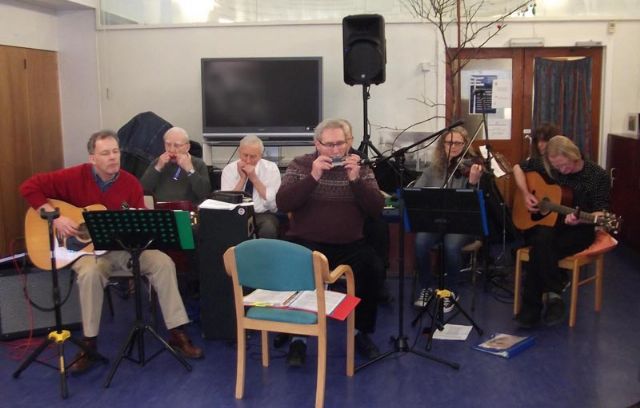
The Muchty Music Makkers
They also provided the audience with song sheets, giving everybody an opportunity to participate. Peter Thomson then told us the story of Rabbie Burns with a mixture of poetry and music.
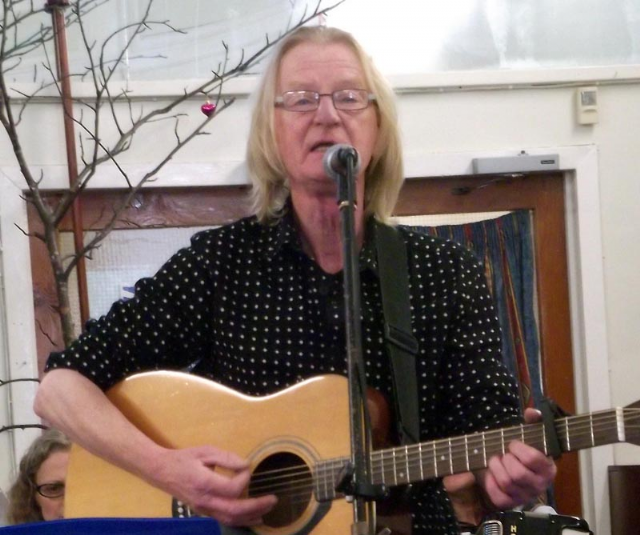
Peter Thomson
Then it was the time for our own member John Dewar to step forward and address the haggis.
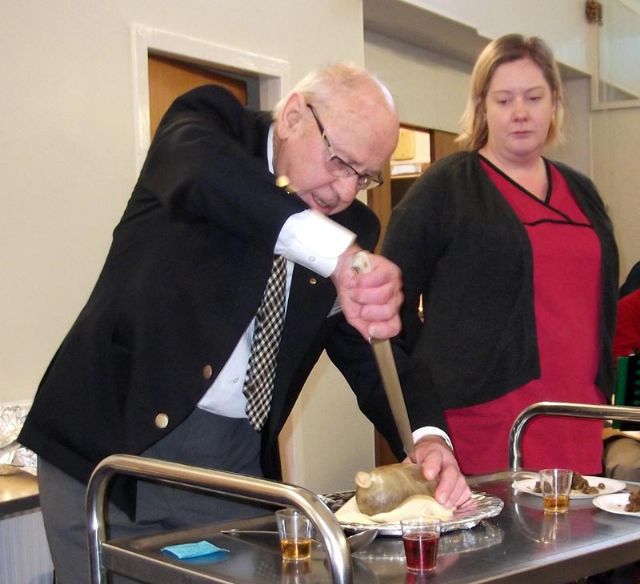
John Dewar, the haggis and Poosie Nancy
He gave us a fluent and entertaining rendition of “To a Haggis”. This was a wonderful turn, with John waving the knife with great gusto! Members were then able to toast the haggis with a choice of either a wee dram or a non alcoholic juice.
Everyone was then served haggis and oatcakes while the band played on! It was really a lovely occasion.
Chairman David Galloway ended the morning by giving a well deserved vote of thanks to our guest entertainers and our own club member John Dewar, with club members expressing their enthusiastic approval.
11 January 2017
ANNUAL GENERAL MEETING
Retiring Chairman Bert Oliver welcomed 40 members to the AGM and wished them a Happy New Year. Reports by the various office-bearers and conveners were presented and overall showed the Club to be in a healthy position. Bert Oliver made his closing remarks on his year in office then presented the new Chairman, David Galloway, with the Badge of Office.
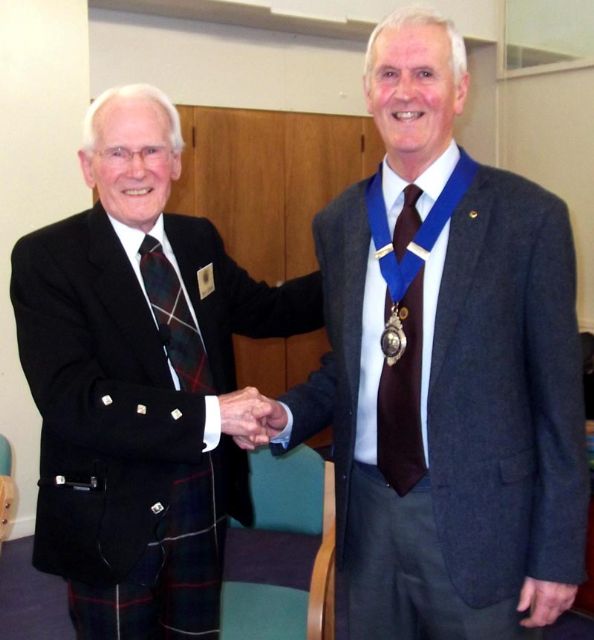
The 2017-18 Office Bearers are:
Chairman - David Galloway,
Vice Chairman – Colin Moore
Secretary – Peter Speirs
Treasurer – Brian Knight,
Past Chairman – Bert Oliver
Asst. Treasurer – Ron Campbell
Committee Members – John Dewar & Robin Thomson.
Full details of these and other positions are on the COMMITTEE page of the website.
The Chairman then introduced the guest performer, Alistair MacFarlane. Alistair is a very welcome and popular return visitor to Cupar Probus Club.
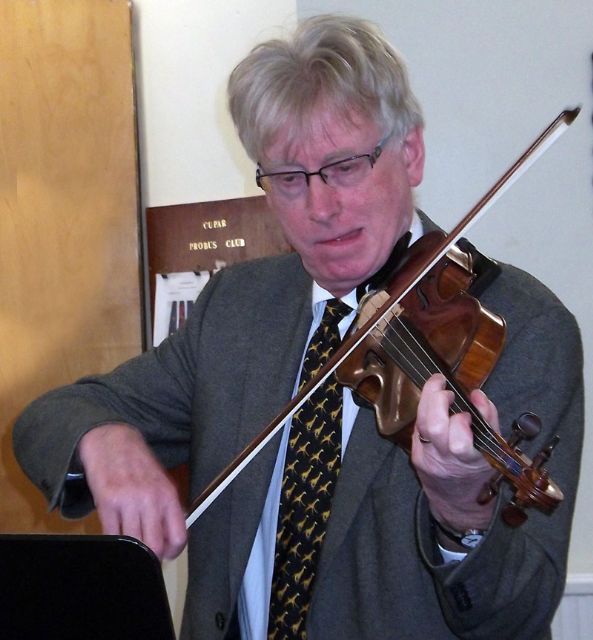
Today, he entertained the club members with a lovely selection of violin "airs" from various parts of the world. These included "Fyvie Castle" by Scott Skinner, a particularly haunting lament. We were also transported to Orkney for two bright and cheerful tunes written by Fiona Dryher, "The Brown Goose" and the "Real Beatrice." Alistair even included some audience participation with rhythm sections arranged with audience hand claps on and off the beat! He used a two hundred and fifty one year old violin which was made by Henry Jay in Piccadilly. This was when Mozart was only a ten year old boy. After all these years it still produced a sweet and harmonious sound. Alistair's performance was well appreciated by all of the members present. We look forward to another entertainment from Alistair on a future occasion.
Meeting report by Colin Moore and David Galloway - Photos by Peter Speirs
